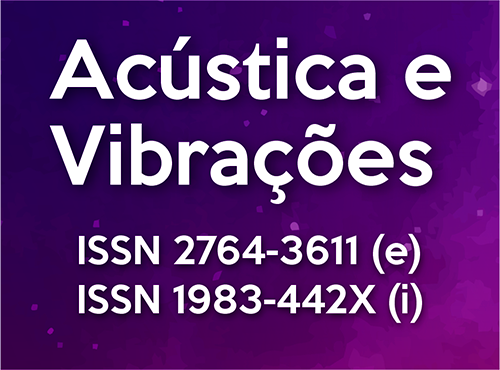Archives
-
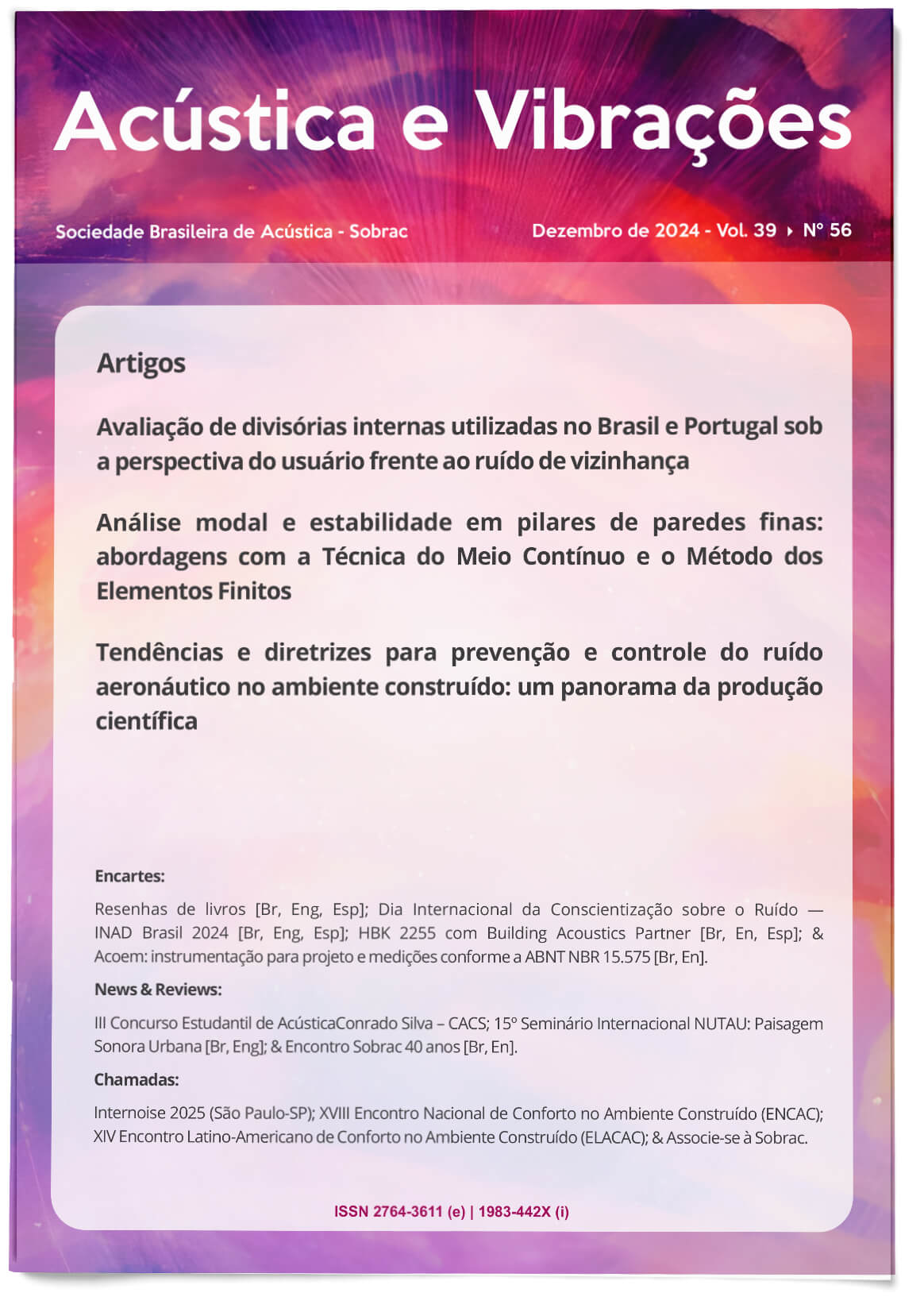
Acoustics and Vibrations Journal 56
Vol. 39 No. 56 (2024)Content Summary:
Articles
- Evaluation of interior partitions used in Brazil and Portugal from the user’s perspective regarding neighbor noise
- Modal analysis and stability in slender wall columns: approaches using the Continuous Medium Technique and the Finite Element Method
- Trends and guidelines for the prevention and control of aircraft noise in the built environment: an overview of scientific production
Inserts
- Book reviews [Br, Eng, Esp]; International Noise Awareness Day — INAD Brazil 2024 [Br, Eng, Esp]; HBK 2255 with Building Acoustics Partner [Br, En, Esp]; & Acoem: instrumentation for design and measurements according to ABNT NBR 15.575 [Br, En].
- News & Reviews: III Student Acoustics Contest - CACS.
Announcements
- Internoise 2025 (São Paulo, SP, Brazil); XVIII National Meeting on Comfort in the Built Environment (ENCAC); XIV Latin American Meeting on Comfort in the Built Environment (ELACAC) and Join Sobrac.
-

Acoustics And Vibration Journal 55
Vol. 38 No. 55 (2023)Editorial
It is with great pleasure that the Editorial Board of the Acoustics & Vibration Journal presents its fifty-fifth edition (Volume 38). In this issue, we renew our commitment to excellence and to the dissemination of knowledge in the field of acoustics, bringing together research that addresses fundamental questions surrounding soundscapes, noise perception, and acoustic control techniques.
Issue 55 features a broad range of approaches to the study of sound and its implications. Especially noteworthy are the articles stemming from the 14th International Seminar NUTAU 2022: Urban Soundscape (which also underwent peer review), in addition to an official translation of a paper from the Journal of the Acoustical Society of America, included at the end of this volume.
The first article, by Andrade and Michalski, examines current uses of the term "soundscape" within Brazilian academia. Their research analyzes the lack of standardization in translating and referencing foundational concepts, which in turn affects interdisciplinary integration and the development of the field in Brazil.
Next, Maciel, Engel, and Zannin discuss the historical evolution and limitations of soundscape studies in urban parks in Curitiba (state of Paraná, Brazil). Their comprehensive review of research conducted at the Environmental Acoustics Laboratory provides insight into the urban and methodological challenges inherent in such studies.
Fernandes, Zannin, Valencio, and da Costa explore the relationship between railway sound and phonophobia. Their article investigates the annoyance generated by railway traffic from the perspective of a "risk society" and environmental rights, underscoring the need for regulation and more in-depth socioacoustic studies.
Soares, Giner, Brites, and coauthors analyze different interventions aimed at controlling highway noise. Using computational modeling, they evaluate solutions such as acoustic barriers, traffic speed reductions, and restrictions on freight vehicles, offering guidelines for urban noise mitigation policies.
Klein and Michalski present a quantitative and qualitative characterization of the soundscape in Bixiga, a traditional neighborhood of São Paulo (SP, Brazil). Their investigation into the area’s history and sonic identity elucidates the cultural and urban impact of sound on the local landscape.
Oliveira, Oliveira, and Vergara analyze the remembered soundscape of the Bebedouro neighborhood (Maceió-AL, Brazil), affected by a socio-environmental disaster. Their study recovers the characteristic sounds of the area prior to its evacuation and explores the impact of losing these sonic elements on community identity and memory.
Peixoto, Ferreira, Klein, Michalski, and Monteiro examine how soundscapes influence work, leisure, and rest during the COVID-19 pandemic. Based on questionnaire data, the research reveals changes in sound perception and the impact of noise on well-being during periods of social restrictions.
Weitbrecht, Monteiro, Jardim, and coauthors propose an approach grounded in low-cost sound monitoring systems and artificial intelligence to assess leisure noise in urban environments.
Finally, Fonseca presents an overview of Acoustical Engineering education in Brazil. Based on an original publication in the Journal of the Acoustical Society of America (2022), the article details the curriculum at the Federal University of Santa Maria (UFSM) and its contribution to training professionals in this field.
This fifty-fifth issue includes five exclusive inserts published in multiple languages with the goal of expanding the reach and accessibility of our content. We begin with a review of four books in the acoustics field, offered in two language versions. Following this, we include a guide to scientific writing of articles in LaTeX and Overleaf—previously published in Portuguese and English—now supplemented by a Spanish version. Lastly, we share key developments from International Noise Awareness Day (INAD Brasil 2023), available in four different languages, underscoring the growing international scope of this campaign.
In the News & Reviews section, we feature two important event reports: the 14th International Seminar NUTAU 2022: Urban Soundscape, whose papers appear in this issue (available in two languages), and the traditional XXX Meeting of the Brazilian Society of Acoustics, held in Natal (RN, Brazil) in 2023, published in Portuguese, English, and Spanish. Both events reinforce the importance of discussing acoustic-related topics in varied contexts, enriching the exchange of experiences and knowledge.
Finally, in our calls for participation, we invite everyone to take part in several important activities: the 40th Anniversary Meeting of Sobrac, to be held in São Paulo (SP, Brazil); the XIII Ibero-American Congress on Acoustics, set to take place in Santiago, Chile, in 2024; and, additionally, we encourage new members to join Sobrac. We hope this edition—marked by thematic and linguistic diversity—will further the advancement of knowledge in acoustics and stimulate the active engagement of our community in future events and publications.
Throughout these pages, we reaffirm our commitment to promoting research in acoustics, vibrations, and related areas. We extend our gratitude to the authors, reviewers, and contributors who have made yet another high-quality edition possible, thereby advancing the body of knowledge in our field.
Enjoy your reading!
Sincerely,
Editors Acoustics & Vibration Journal
Issue No. 55, December 2023.Conteúdo em resumo:
Artigos
- Usos correntes da terminologia de paisagem sonora na Academia Brasileira
- Evolução histórica e limitações dos estudos de paisagem sonora em parques urbanos em Curitiba – Paraná
- O Som ferroviário é uma fobia sonora? Reflexões sobre acústica, direitos ambientais e sociedade de risco para subsidiar o planejamento da paisagem sonora
- Análise de diferentes intervenções para o controle de ruído de uma rodovia: um estudo de caso considerando barreiras acústicas, velocidade de tráfego, tipos de veículos e asfalto
- Caracterização quantitativa e qualitativa da paisagem sonora do Bixiga, bairro tradicional da cidade de São Paulo: Estudo preliminar da historicidade e cultura das marcas sonoras do Bixiga
- Paisagem sonora rememorada do bairro de Bebedouro (Maceió – AL) afetado por desastre socioambiental
- Influência da paisagem sonora na qualidade do trabalho, lazer e descanso durante a pandemia de COVID-19
- Avaliação do ruído de lazer em meio urbano: uma abordagem baseada em sistemas de monitorização sonora de baixo custo e na inteligência artificial
- Engenharia Acústica: Um curso acadêmico completo de graduação no Brasil
Encartes:
- Resenhas de livros [Br, Eng]; Introducción a LaTeX y cómo iniciar un nuevo proyecto en Overleaf; Dia Internacional da Conscientização sobre o Ruído — INAD Brasil 2023 [Br, Esp, Eng, Ita]; 14º Seminário Internacional NUTAU: Paisagem Sonora Urbana [Br, Eng]; e XXX Encontro da Sociedade Brasileira de Acústica [Br, Eng, Esp].
Chamadas: Convite: Sobrac 40 Anos; XIII Congresso Ibero-Americano de Acústica (FIA 2024); e Associe-se à Sobrac.
-
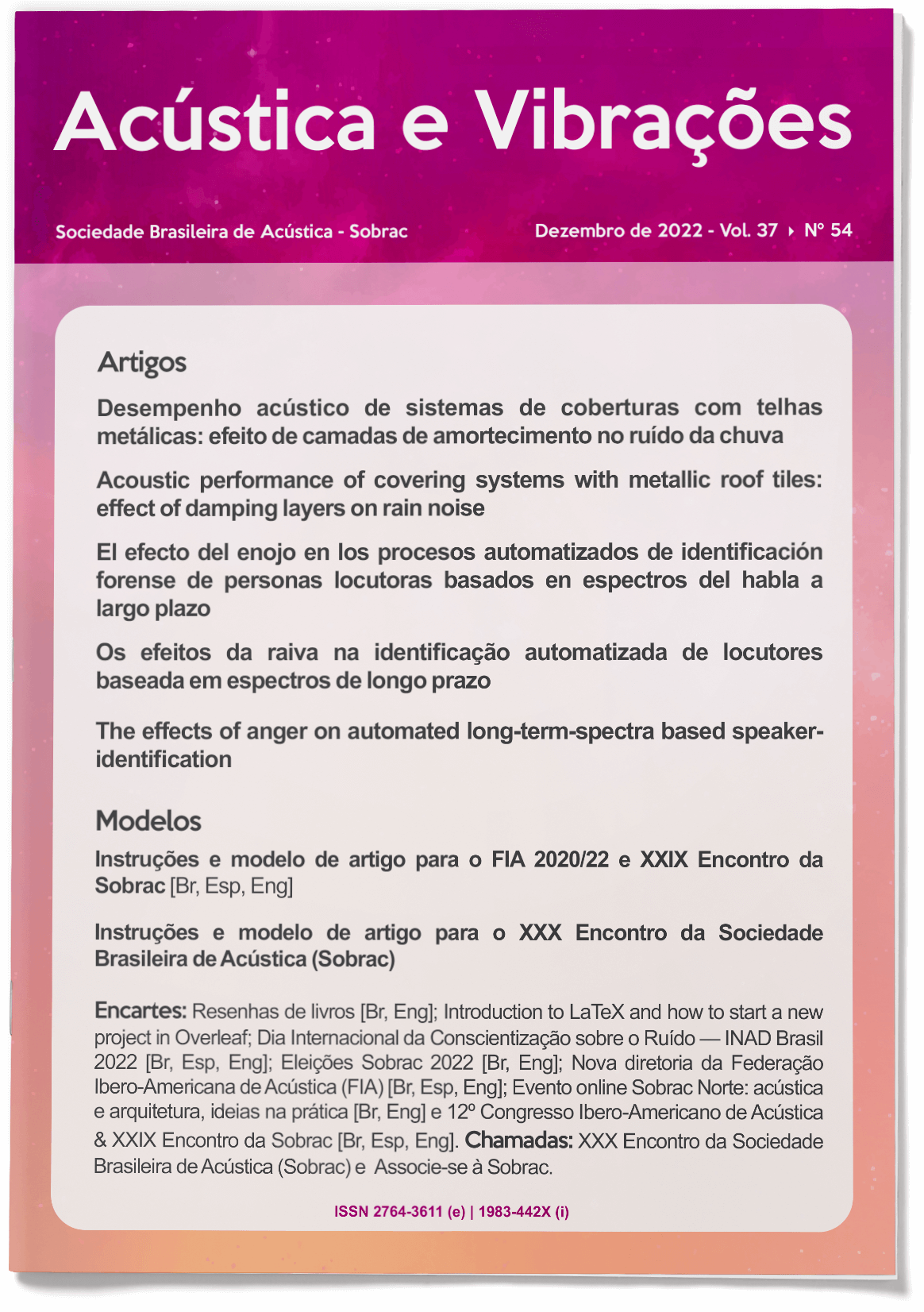
Acoustics and Vibrations Journal 54
Vol. 37 No. 54 (2022)It is with great pleasure that the Editorial Committee of the Acoustics & Vibrations Journal has the honor of presenting its fifty-fourth edition (volume 37). In this issue, we continue on the path of innovation and international expansion, an effort that materializes in the welcoming of bilingual — and, boldly, trilingual — contributions, in Portuguese, Spanish, and English. It is already possible to observe the reflection of this initiative on the pages now offered to you.
In this moment of transition, we still feel the remnants of the pandemic that afflicted us. However, the journal not only survives but also reinvents and strengthens itself, navigating through waters of modernization and restructuring. Despite the challenges that persist in the panorama of scientific production and the development of applied technical works, it is with enthusiasm that we note the vigorous advancement of science in acoustics, vibrations, and audio.
This issue, therefore, is not just a testament to the resilience of our scientific community, but also a celebration of the incessant human desire for knowledge and innovation. We invite our readers to dive into the following pages, where they will find not only novelties but also the confirmation that, even in the face of obstacles, our journey in search of excellence and knowledge never ceases.
The 54th edition of the Acoustics & Vibrations Journal} presents a collection of eleven unique texts. However, this number reveals even greater richness when we contemplate the works in their multiple languages: considering the translated versions, the collection expands to a total of twenty-six texts.
In this edition, we highlight the investigation by Wittmann, Heissler, and Oliveira on the acoustic performance of roofing systems with metal tiles, focusing on the impact of dampening layers on rain noise. This study is set in a contemporary context of climate changes, with noticeable lterations in rain patterns, which in turn can directly influence acoustic quality in buildings, especially those with large spans. Analyzing 12 different roofing configurations under artificial rain conditions, the authors demonstrate that the integration of glass wool between the metal tiles is the most effective, significantly reducing noise transmission. This article is a great read for architects, engineers, and builders looking for solutions to improve acoustic comfort in indoor environments. The article is available in Portuguese and English.
The article by Ortega-Rodríguez, Solís-Sánchez, Valverde-Méndez, and Venegas-Li (a collaboration between researchers from Costa Rica and the United States) examines how intense emotions, such as anger, can distort acoustic signals and, consequently, affect the accuracy of forensic speaker identification. Using advanced techniques to analyze long-term speech spectra, the researchers found that even moderate levels of anger can significantly alter identification outcomes, moving them toward a completely different speaker. This discovery highlights the need for caution when applying these methods in forensic situations, especially when emotions are involved. The article is available in Spanish, Portuguese, and English.
This edition also presents contents originating from two significant milestones in the field of acoustics in Brazil. We begin with a highlight on the 12th Ibero-American Congress of Acoustics (FIA 2020/22), an enriching collaboration with the XXIX Meeting of the Brazilian Society of Acoustics (Sobrac), held in the picturesque city of Florianópolis, SC, from August 28 to 31, 2022. Advancing in time, we turn our attention to the XXX Meeting of Sobrac, scheduled to occur in the vibrant city of Natal, RN, from November 19 to 22, 2023, promising to be another milestone for the acoustic community.
For those interested in the FIA, this edition brings the three models for article submission for the event, in Portuguese, Spanish, and English. Additionally, a report on the congress, kindly provided by professors Júlio Cordioli and Sérgio Silva, enriches the news section, offering a perspective on the developments and discussions that took place there. Regarding the XXX Meeting of Sobrac, we invite our readers to familiarize themselves with the article model specific for this event, along with a detailed call for papers that sheds light on what to expect from the upcoming meeting.
In the inserts, the book review section brings four works, namely: Room Acoustics: Design and Modeling; Virtual Experiments in Mechanical Vibrations: Structural Dynamics and Signal Processing; Array Signal Processing: Concepts and Techniques; and Acoustics in Building Rehabilitation — with the first two commented on by the authors themselves —, this insert is available in Portuguese and English. In this section, it is also possible to check the insert in English (previously published in Portuguese), which explains the principles of the LaTeX writing system — in which our journal is also edited —, in addition to teaching how to start a new article project using the A&V template. Lastly, we find the report from INAD Brazil 2022 (in three languages), a campaign to raise awareness that this year brought the motto ``In childhood, fun and protection. No noise!'', to draw attention to the dangers of noise for those at a tender age.
In our news section, we find two texts written by Professor Dinara Paixão, the first of which reports on the Sobrac 2022 electoral process (in Portuguese and English). The second deals with the new FIA Board of Directors, in addition to elaborating details of the entity (available in three languages). Also in this section, Paulo Chagas signs the text (bilingual) that informs about the acoustic event organized by the North Regional of Sobrac.
Finally, in the calls section, we have details about the XXX Meeting of Sobrac and an invitation for you to join Sobrac.
As you flip through the pages of this edition, we hope that you, dear reader, will be enveloped by the spirit of discovery and the shared passion for acoustics, motivating you to contribute to the continuous growth of this fascinating field.
We would like to thank Sobrac, the authors, and the technical reviewer group for their contribution to this edition.
Enjoy reading!
Cordially,
A&V Editors nº 54, December 2022.
Content in summary:
Articles
- Desempenho acústico de sistemas de coberturas com telhas metálicas: efeito de camadas de amortecimento no ruído da chuva
- Acoustic performance of covering systems with metallic roof tiles: effect of damping layers on rain noise
- El efecto del enojo en los procesos automatizados de identificación forense de personas locutoras basados en espectros del habla a largo plazo
- Os efeitos da raiva na identificação automatizada de locutores baseada em espectros de longo prazo
- The effects of anger on automated long-term-spectra based speaker-identification
Templates
- Instructions and article template for FIA 2020/22 and XXIX Sobrac Meeting [Br, Esp, Eng]
- Instructions and article template for the XXX Meeting of the Brazilian Society of Acoustics (Sobrac)
Inserts: Book reviews [Br, Eng]; Introduction to LaTeX and how to start a new project in Overleaf; International Noise Awareness Day — INAD Brazil 2022 [Br, Esp, Eng]; Sobrac Elections 2022 [Br, Eng]; New board of the Ibero-American Federation of Acoustics (FIA) [Br, Esp, Eng]; Online event Sobrac North: acoustics and architecture, ideas in practice [Br, Eng]; and 12th Ibero-American Congress of Acoustics & XXIX Sobrac Meeting [Br, Esp, Eng].
Calls: XXX Meeting of the Brazilian Society of Acoustics (Sobrac) and Join Sobrac.
-

Acústica e Vibrações 53
Vol. 36 No. 53 (2021)Editorial in English
With a huge satisfaction, the Editorial Committee of Acoustic & Vibrations Journal (Revista Acústica & Vibrações) presents its 53rd edition. This issue brings great news: the Journal is now open to the community and meets the indexing criteria of the main databases with the addition of the DOI digital identifier. In addition, it has its own site (https://revista.acustica.org.br), which contains the archive with all editions already published.
Here’s a little history about Acoustic & Vibrations Journal. Conceived in 1985 by the Brazilian Acoustic Society (Sobrac), it was just a Bulletin for the entity’s associates. However, with the growth of the area, in November 1988, it reached the status of Journal, covering a greater technical-scientific content. Over the years it has gone through many stages, and in 2021 it opens to the community, indexes and adds the DOI digital identifier.
Issue number 53 of Acoustic & Vibrations Journal has seven articles from different branches of the acoustics and vibrations area.
The article by Bárbara Fengler, Karina Sá, Raquel Rossatto, and José Carlos Giner presents an initial study using a model in Building Information Modeling (BIM) from the Industry Foundation Classes (IFC) data schema, and the IfcOpenShell tool, to estimate the acoustic performance of a partition.
The work from Jacson Vargas, Hideraldo Santos, Lucas Kulakauskas, Arcanjo Lenzi and Olavo Silva, from the Laboratory of Vibrations and Acoustics (LVA), at the Federal University of Santa Catarina, presents an experimental analysis of noise sources in a front-loading washing machine. The contributions of the noise radiated by the engine, the tank and the washing machine cabinet were characterized. The results confirm the preliminary hypothesis that the electric motor is the main source of noise in the analyzed washing machine.
The study by Ranny Michalski, Alessandra Shimomura and Roberta Mülfarth, from USP, analyzed and compared urban noise conditions before and during the pandemic in downtown São Paulo, SP, in order to verify the changes between the two scenarios. The results show a reduction in the measured values and confirm the hypothesis that the adopted measures of social restriction had an impact on the urban soundscape.
Fernanda Caldas and Bruno Masiero, from Unicamp, carried out an evaluation study of three sparsity promoting algorithms to determine the direction of sources in a sound scene using a spherical array of microphones in three conditions: simulated scenes with and without additive noise and a real situation with a source recorded in an almost anechoic environment. In the case of simulated scenes, the algorithms showed a satisfactory result, being able to accurately determine the number of sources and their directions.
The article by Valdiney Sousa and Alexandre Teixeira presents a different and easier interpretation on the topic “vibration dose”, by defining a dimensionless dose for whole-body vibration and applying it in known examples in technical guides.
The article by Tais Felipetto, Maria Fernanda de Oliveira, Fernanda Rossatto, Lorenzo Kerber and Rafael Heissler seeks to identify changes in attenuators for noise control in air conditioning systems with the incorporation of reused sound-absorbing materials and arrives at results of sound absorption coefficients very close to those of primary materials.
The article by Tamáris da Costa Brasileiro-Meneses, Virgínia Araújo and Bianca Carla Dantas de Araujo presents a compilation of parameters used for environmental noise assessment in standards and environmental laws of South American countries. From the research, it was concluded that, in general, countries define the permitted sound levels based on urban zoning and the division between night and day periods, with Paraguay being the only country that presented specific values for peak hours.
Closing the scientific articles section, the article by Viviane Melo, Roberto Tenenbaum, Edna Sofia Santos, Murilo Soares and Gabriel Sampaio, from UFSM, presents a validation study of the results from RAIOS 7 computer code for numerical simulation of room acoustics with auralization. The calculation of acoustic parameters and impulse responses both monaural and binaural are validated.
Issue 53 also has nineteen inserts, presented in the Calls and News & Reviews sections. Details are presented on: the activities of INAD 2021, the closing of the International Year of Sound 2020 & 2021, the reviews of five books in the field of acoustics and vibrations (in english and portuguese), the mutual cooperation agreement signed between Sobrac and the Portuguese Society of Acoustics (SPA), the critical listening room under construction at Unicamp, the Young Acousticians Network (YAN), Sobrac’s electoral process for 2021–2022, the International Festival of Music at Home (Fimuca Áudio), the online Workshop: Acoustic urban planning in cultural zones, the 1st Virtual Colloquium “Cuscuz com Acústica”, and the 2nd Academic Month of the Acoustical Engineering (UFSM).
The News & Reviews section also has a short article about a new application for the Brüel & Kjær sound level meter, model 2245, called Product Noise Partner that makes measuring sound power much easier. Another very interesting article in the section is about room acoustics simulations developed at Brazilian universities. Following, informations concerning the Acoustical Engineering program, winner of the five stars given by Estadão News’ College Guide. Finally, there is a list with upcoming events in acoustics throughout Brazil and the world.
We also have calls in this issue: how to publish articles in the journal; how to join Sobrac; and information about FIA 2020/2022 and about the VII Southern Seminar on Acoustics and Vibrations (Segav).
We would also like to take the opportunity to invite the reader to the 12th Ibero-American Acoustics Congress (FIA) together with the XXIX SOBRAC Meeting, which will be held in Florianópolis, from August 28 to 31, 2022, rescheduled again due to the pandemic. The program will include lectures by world-renowned experts, as well as presentations of papers and posters on topics related to the areas of Acoustics and Vibrations. A technical exhibition with the latest advances in products and equipment will take place in parallel with the Congress. We also invite you to the VII Southern Seminar on Acoustics and Vibrations, held in person in São Leopoldo, RS, on September 23, 2022.
We would like to thank Sobrac, the authors and the group of reviewers for their contribution to this edition (which breaks a page record, being the largest ever published).
Enjoy reading!
Cordially,
Editors A&V n◦ 53, December 2021.
William D’Andrea Fonseca and Ranny L. X. N. Michalski
Summary content:
- Simulation of the acoustic performance of a BIM model from the IFC data schema;
- Experimental analysis of noise sources in a washing machine with the aid of order analysis;
- Assessment of urban noise during the COVID-19 pandemic: a case study in downtown São Paulo/SP;
- Evaluation of sparsity promoting algorithms for locating sources with spherical arrangement of microphones;
- Vibration dose, a different approach on the theme;
- Attenuators for noise control in air conditioning systems: studies with the use of reused materials;
- State of the art legislation on environmental noise in South America;
- Validation of room acoustic simulation program via international intercomparison and intelligibility measurement; and
- Inserts: Publish your article in Acústica e Vibrações; Join Sobrac – Sociedade Brasileira de Acústica; XII Iberoamerican Congress of Acoustics and XXIX Meeting of Sobrac; VII SeGAV – Gaucho Seminar on Acoustics and Vibrations; International Noise Awareness Day — INAD Brasil 2021; End of the International Year of Sound; Book reviews; Sobrac and SPA sign a mutual cooperation agreement; The new “Sound of Silence” at Unicamp; Young Acousticians Network – YAN; Sobrac Elections 2020; International Festival of Music at Home; Online workshop: Acoustic urban planning in cultural zones; 1st Virtual Colloquium of Sobrac NE; II Academic Month of Acoustic Engineering (Federal University of Santa Maria); HBK 2245 Product Noise and 2245 Open API; Room Acoustics Simulations developed in universities in Brazil; Brazil has a 5-star Acoustic Engineering course; and acoustic events in Brazil and around the world.
-

Acústica e Vibrações 52
Vol. 35 No. 52 (2020)It is with great satisfaction that the Editorial Committee of Acoustic & Vibrations Journal (Revista Acústica & Vibrações) presents issue number 52, containing a series of novelties. We started by elaborating on the commission structure itself. Already in this issue we have the assistance of Associate Editors Ranny Michalski and Olavo Silva, professionals with extensive experience in A&V topics. Their contribution furthers the journal's growth. In this issue we have also counted upon Guest Editor Paulo Mareze, professor in the Acoustical Engineering Program at UFSM.
In this edition we have seven technical-scientific articles and eleven inserts. The reader can access:
- Complete magazine;
- Complete inserts;
- Articles separately; or
- Inserts separately.
Just see the links here below. Each item has its own page and it is very easy to export the bibliography, if necessary.
We hope, with each edition, to publish works from the most varied branches of acoustics and vibrations. To this end, we are investing in increasing the journal's attractiveness with the creation of new sections, with more space dedicated to the dissemination of tools and events, and with the expansion of advertising in academic circles. We would also like to thank Sobrac, the authors, and the group of peer-reviewers for their hard and dedicated work, which were essential to transform this publication into reality.
Enjoy reading!
Cordially,
Editors A&V, nº 52, July 2020.
William D’Andrea Fonseca, Ranny L. X. N. Michalski, Olavo M. Silva e Paulo Henrique Mareze
Summary content:
- Optimization of a labyrinthine acoustic metamaterial for sound absorption in the frequency range of 100 – 300 Hz;
- Development and optimization of automotive muffler oriented to Formula Student prototypes;
- Adjustment of a middle ear lumped parameters model using different objective functions;
- Occupational risk exposure to hand-arm vibrations in the operation of orbital sanders in carpentry shops;
- Acoustic adaptation of Teatro Armando Gonzaga through computer simulation;
- Perception of the acoustic quality of environments by students of Architecture and Interior Design courses;
- Initial considerations on noise regulation for eVTOL aircraft;
- Calls: Publish in A&V, Writing the article in LaTeX/Overleaf, Join Sobrac, INAD Brasil 2020, International Year of Sound 2020-2021, FIA/Sobrac Congress 2020, V SeGAV, Acoustic Congresses around the world and Proceedings online; and
- News & Reviews: Book reviews, New sound level meter B&K 2245 and FAU USP Seminar on Sound Mapping.
-

Acústica e Vibrações 51
Vol. 34 No. 51 (2019)Editorial
Dear Acoustics and Vibrations reader, it is with great pleasure that we bring you this copy. This edition has a free version, which contains only the first page of each article, in order to provide more support so that those not yet associated with Sobrac can evaluate one of the advantages of subscribing (see details on how to become a member in the section ).
Here we have five articles, starting with the work of Bruna Croce and Júlio Torres from UFRJ, which addresses a relevant topic related to the problem of noise in hospitals. In addition to the methodology used in the evaluation, there is a discussion that will certainly be taken forward by our community, related to the maximum levels allowed by the ABNT 10151 standard.
The article by Ranny Michalsky and Giovanna Caparroz (FAU/USP) describes the production of a noise map of a region in downtown São Paulo, seeking to relate it to the population's impressions of the local soundscape. One of the interesting points is the beginning of a more humanized discussion about the problem of urban noise, whose perception also depends on other senses, in addition to hearing.
The researchers from UFRN, Tamiris, Luciana, Débora, Virgínia and Bianca, who signed the third article, bring us an interesting compendium of noise maps already made in Brazil and discuss other sources of information that could generate geo-referenced data. In this article, some maps of complaints about noise pollution are also presented.Vanessa Mariz and Camila Araújo, from UFMG, carried out a study with engineers and architects, all professors, to quantify the concern with acoustics in their projects. According to their results, there is a concern in about 60% of the population studied. Such a study should encourage us to promote and intensify awareness campaigns.
Closing the scientific articles section, Rodolfo Thomazelli and Stelamaris Bertoli, from FEC/Unicamp, present us in detail the design, construction and evaluation of a specific impedance tube for sound impedance measurements at low frequencies, as required when evaluating Helmholtz resonators.In addition to scientific articles, in the Calls section, the reader will find a text by our Editor-in-Chief, encouraging publications in the journal Acústica e Vibrações. Be sure to read and check the types of articles accepted for publication, as well as some suggestions on topics to be addressed.
We could not fail to highlight here the texts on two world actions, with their respective
coordinations in Brazil, to raise awareness of issues related to sound: INAD and the Year
Sound International. Check out the details and get involved in these campaigns, whose success depends on our performance!Several calls for scientific events on acoustics and vibrations that will take place in the years 2020 and 2021 are presented towards the end of this edition of ours, with emphasis on the XII Iberoamerican Congress of Acoustics (FIA) and XXIX Sobrac Meeting that will be held jointly in 2020, at the paradise Florianopolis. In addition to the opportunity to exchange experiences and knowledge, the event reminds us of the first edition of the FIA, which took place in the same city in 1998.
In order to achieve an increasing quality and visibility, in addition to the authors, we publish here a special and nominal thanks to the referees and reviewers who dedicated themselves to reading and criticizing the submitted articles. We remind you here that, even when an article is not accepted, the opinion fulfills a function of knowledge construction and serves to "tune" our speeches.To close this issue, we have another novelty, the new section called News & Reviews, with three very interesting mini technical articles. One of them on the construction of a computational model and simulation of Theatro Treze de Maio, in Santa Maria (RS), by Caroline Gaudeoso and William Fonseca (UFSM). Carolina, Marcel, Marcos and Paola bring us the description of a critical listening room built in the company Harmonia, according to national and international standards. Finally, Rémi Guastavino (adapted by Rose Esteves and William Fonseca) presents us with a description of the new artificial head from Brüel & Kjaer with a construction that reproduces characteristics of the auditory system and the human phonatory system, for the most diverse purposes, such as development in the fields of communication and entertainment.
Thank you very much and a great read!
Sincerely,
Prof. Dr. William D'Andrea Fonseca
Prof. Dr. Marcio Henrique de Avelar GomesSummary content:
- Evaluation of the Acoustic Quality in the Surroundings of the Clementino Fraga Filho University Hospital (HUCFF);
- Sound evaluation of urban spaces in the central area of São Paulo: the case of Avenida Ipiranga;
- Sound Maps: history and survey of current Brazilian production;
- Acoustics: the professor's view on project development and the impact on hearing health;
- Low frequency impedance tube: construction and validation; and
- Calls & News and Reviews.
-
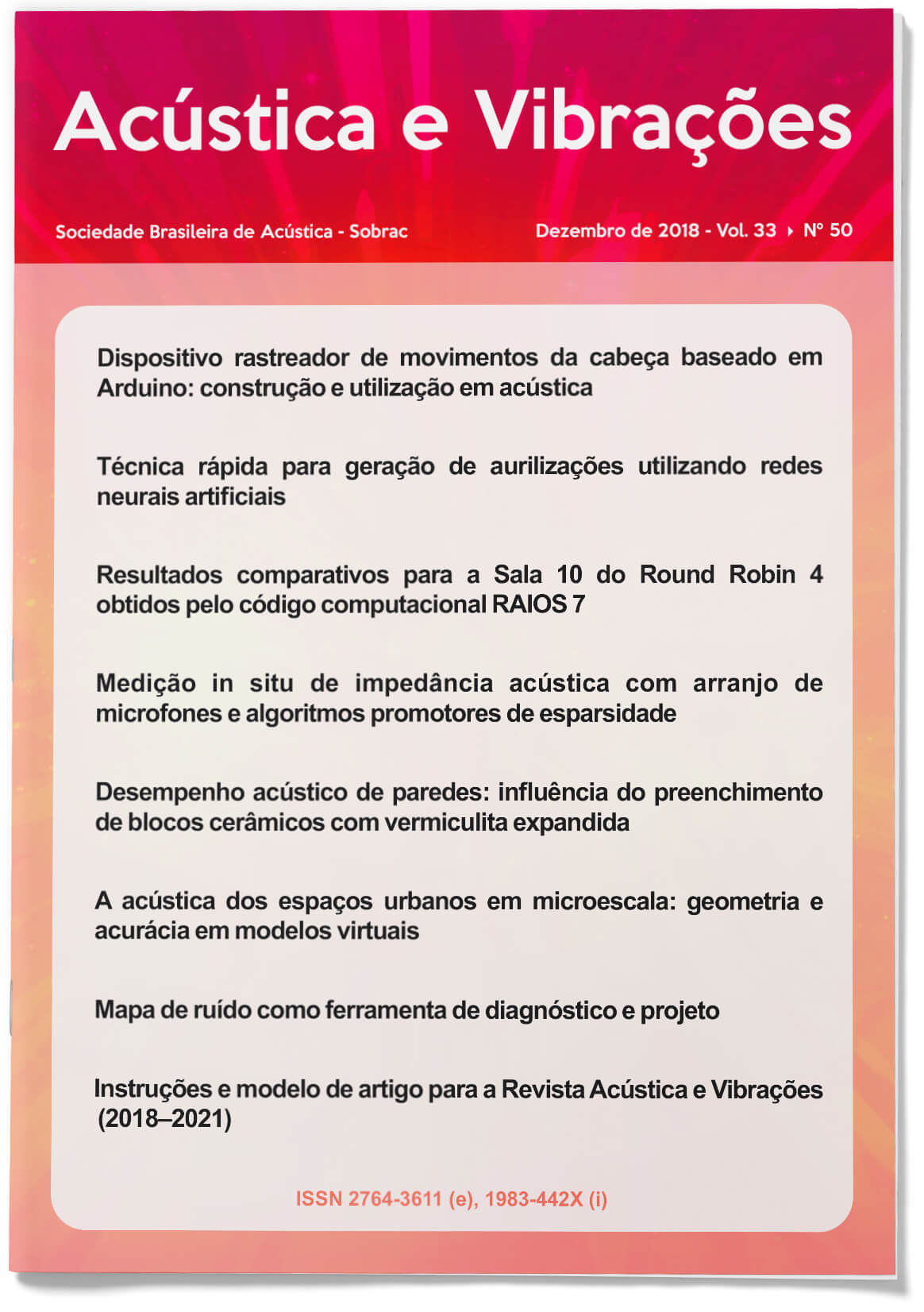
Acústica e Vibrações 50
Vol. 33 No. 50 (2018)Editorial
The Editorial Committee of Revista Acústica e Vibrações presents the commemorative Edition n°50 with great satisfaction. It brings several news for authors and readers, that is, innovations for the magazine and articles it contains.
Internationalization is important for scientific and technical journals, promoting access to content by a wider audience. Thus, seeking internationalization for A&V, the first page of each article will act as the identification of the work/article. It will contain, in addition to the title, names, affiliations, abstract and keywords, also (the new fields) PACS, title, abstract and keywords.
As a novelty, still on the first page, there will be a unique identification code, the so-called DOI (Digital Object Identifier), with the article being registered in an international database, facilitating access so that it can be found on the internet. As a result, more access is expected and the articles are more cited.
The file templates (templates) for writing new articles were renewed, and versions for writing in Latex and Ms Word are now available. They are available both on the Sobrac website and on the Overleaf_ The instructions were all rewritten, contemplating writing and formatting rules. With this, the styles are standardized, making the submissions already in the final format of the article. From this number onwards, bibliographic references are numbered (as permitted by Brazilian regulations).
The complete digital magazine (in PDF), now contains clickable links and bookmarks, making navigation easier. All articles open on the right, so eventually some blank pages appear in the full issue.
With the aforementioned updates, Revista Acústica e Vibrações has its layout similar to the major magazines in the field, such as the Journal of the Acoustical Society of America it's the Journal of Sound and Vibration.
A&V is, as we know, a gathering magazine covering several areas of knowledge. In this issue we bring seven articles, organized in an order in which some connection with the consequent is sought.
The first article is about building a head tracking device using hardware low-cost. Next, there is an article with the use of artificial neural networks for the application in virtual acoustics, also using HRTFs.
Still employing a lot of signal processing, the third article presents “Comparative results for Room 10 of Round Robin 4 obtained by the computer code RAIOS 7”, clarifying the scenarios and showing the objective parameters obtained. In the fourth article, we explore the use of microphone arrays for in situ of acoustic impedance, a parameter of notable importance in computational acoustics.
In the fifth article, the magazine goes in the direction of building systems and architecture, presenting the “influence of filling ceramic blocks with expanded vermiculite” for walls, including experimental aspects and relevant results.
The sixth article bridges the gap between architecture and virtual models for simulation, discussing geometry details and simulation results. Finally, the last article (not least) brings the “noise map as a diagnostic and design tool”, highlighting regulatory aspects and examining results.
After the technical articles, there are still some elements at the end of this issue. The first one is the model article, entitled “Instructions and article model for Revista Acústica e Vibrações (2018–2021)”, which can be used as a guide for authors.
Next, there are the calls: join Sobrac (with information for new people interested in joining), special call for the 12th Iberoamerican Congress of Acoustics - FIA 2020 together with the XXIX Sobrac Meeting (which will be held in Florianópolis, SC) and a dedicated section with a nice list of “acoustic congresses around the world”, listing dates, venues and websites. Also, a brief description of the process of creating the commemorative cover of this issue is placed in the final insert. Finally, the issue closes with the English-language editorial.
It is very important to thank the Sobrac Board of Directors for the invitation, the authors and the group of reviewers, for their hard and beautiful work, essential to make this publication a reality.
Cordially,
Prof. Dr. William D'Andrea Fonseca
Summary content:
- Arduino-based head movement tracking device: construction and use in acoustics;
- Fast technique for generating aurilations using artificial neural networks;
- Comparative results for Room 10 of Round Robin 4 obtained by the RAIOS 7 computational code;
- In situ measurement of acoustic impedance with array of microphones and algorithms promoting sparsity;
- Acoustic performance of walls: influence of filling ceramic blocks with expanded vermiculite;
- The acoustics of urban spaces on a microscale: geometry and accuracy in virtual models; and
- Noise map as a diagnostic and design tool.
-
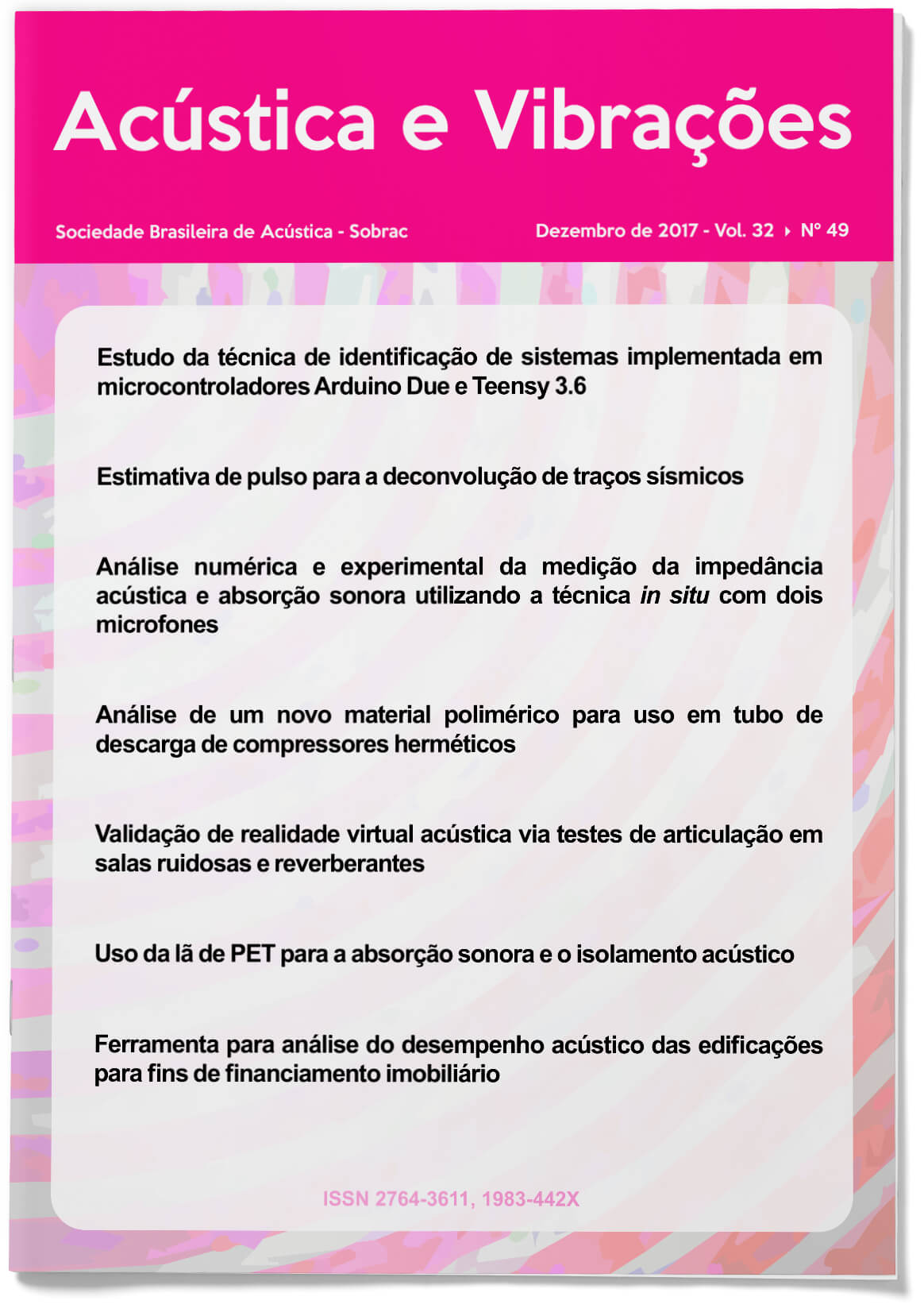
Acústica e Vibrações 49
Vol. 32 No. 49 (2017)Editorial
The Editorial Committee of Revista Acústica e Vibrações presents Issue n°49. This issue has seven articles covering subjects related to signal processing applied to the technique of system identification and seismic trace deconvolution; numerical and experimental analysis of the measurement of acoustic impedance and sound absorption; determination of mechanical properties for noise control; acoustic virtual reality and building acoustics.
The edition begins with a work that addresses aspects such as: signal post-processing, filters, active control and instrumentation. All this aimed at implementing the system identification technique on relatively low cost AD/DA-DSP platforms such as Arduino. In the work, mathematical optimization tools are used together with filtering techniques. The approach is theoretical-practical and the hardware implementation is conducted and tested under both headphone and headphone conditions. The discussion is fruitful regarding the difficulties and limitations of the chosen platforms.
The second article addresses the issue of seismic imaging from signal post-processing methods, using and discussing aspects of the deconvolution between the seismic trace and the pulse emitted by the source. Furthermore, a least squares algorithm is used in conjunction with an adaptive filter to recover the original signal. The theory is previously presented and there are relevant discussions in simulated and real data, showing the effectiveness of the techniques.
Subsequently, there is a work that combines experimental and numerical aspects. The topic is the measurement of acoustic impedance and sound absorption in situ, using the technique of two microphones (or PP probe). Furthermore, a modeling is presented for comparative purposes using the Finite Element Method. The approaches are put into practice for some specific samples/cases, clarifying details and limitations inherent to the methodologies.
The following article proposes a constructive change in hermetic compressors used in refrigerators capable of contributing significantly to the reduction of noise in an environment. It is a great example related to engineering practice, which combines knowledge of solid mechanics, vibrations, acoustics and numerical methods applied to noise control in the sound source. The reader will be pleased to read about the use of a Timoshenko beam model applied to the experimental survey of parameters that are used in the finite element modeling of the compressor, which is used to measure the expected reduction in vibratory power of this refrigerator component.
An approach to the evaluation of the quality of an aurilization (or auralization) is the subject of the article “Validation of acoustic virtual reality via articulation tests in noisy and reverberant rooms”. This work is an evolution of the one presented in our previous edition, now in situations where both reverberation and background noise are greater. Results obtained by carrying out the tests in two rooms were compared with those obtained from the computer simulation of these environments.
To close the articles section, we bring two works related to building acoustics. The first one presents a characterization of materials in which its main component is PET wool in terms of air and impact insulation, as well as the sound absorption coefficient. The maintenance of their properties over the years and use was also evaluated, according to a standardized procedure. In addition to a promising result obtained from the reuse of waste, we highlight the clear presentation of the procedures described in the most current standards.
The second of these articles presents the creation of a database that provides information on aerial and impact sound insulation for different types of national building elements, something urgent and essential to make the designer's work more efficient. Such a database is presented in the form of an electronic spreadsheet that can be fed by its users with experimental data obtained both in laboratories and in the field. In addition to enabling the cataloging of this data, models for estimating isolation in specific situations were programmed and facilitate the use of the tool for prior assessments, which can be used by real estate financing agencies.
We close this edition with the presentation of a novelty: the I Conrado Silva Student Contest, whose regulation can be read in this volume. This initiative aims to increase the visibility and encourage the involvement of students from different courses with Acoustics. The contest is part of the activities related to the XXVIII SOBRAC Meeting, to be held in October 2018 in Porto Alegre, an event to which we are pleased to invite you!
The editors of Revista Acústica e Vibrações – issue n.49 – thank to the SOBRAC Board of Directors for the invitation, to the authors and to the group of reviewers, whose work was essential to make this publication a reality.
Sincerely,
Prof. Dr. William D'Andrea Fonseca
Prof. Dr. Dinara Xavier da Paixão
Prof. Dr. Marcio Henrique de Avelar GomesSummary content:
- Study of the system identification technique implemented in Arduino Due and Teensy 3.6 microcontrollers;
- Pulse estimation for the deconvolution of seismic traces;
- Numerical and experimental analysis of the measurement of acoustic impedance and sound absorption using the in situ technique with two microphones;
- Analysis of a new polymeric material for use in the discharge tube of hermetic compressors;
- Validation of acoustic virtual reality via articulation tests in noisy and reverberant rooms;
- Use of PET wool for sound absorption and acoustic insulation; and
- Tool for analyzing the acoustic performance of buildings for real estate financing purposes.
-
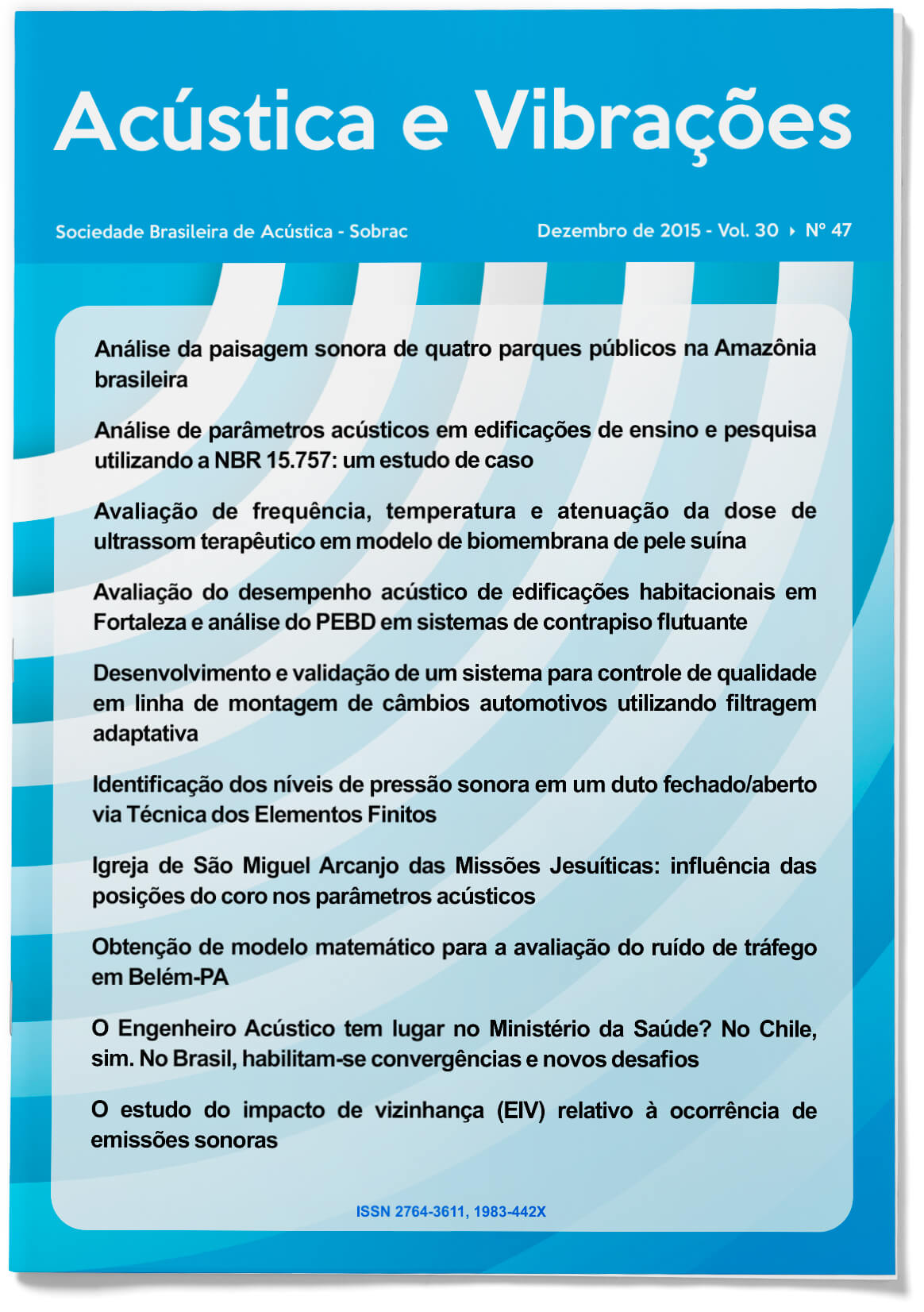
Acústica e Vibrações 47
Vol. 30 No. 47 (2015)Editorial
We reached the end of 2015, which was marked by the commemoration of SOBRAC's 30th anniversary, celebrated in a memorable event in Rio de Janeiro-RJ, in November, under the coordination of Professor Maria Lygia Alves de Niemeyer.
The challenges are great and the country faces a crisis of great proportions, however, we see a growth in the demand for projects and services in the areas of Acoustics and Vibrations, either because of the growing awareness of better qualified environments, or because of the pressure arising from NBR 15.575 .
In this way, the production of research in these areas of knowledge becomes even more relevant, emphasizing the importance of our Revista Acústica e Vibrações, as the main national vehicle for the dissemination of scientific research produced by the members of our society.
Finally, we take advantage of this space to, once again, thank everyone who contributed by sending articles to this Journal, thus subsidizing its continuous and solid growth and, consequently, of our Brazilian Society of Acoustics.
Gustavo da Silva Vieira de Melo
Newton Sure Soeiro
Articles:
- Analysis of the soundscape of four public parks in the Brazilian Amazon
- Analysis of acoustic parameters in educational and research buildings using NBR 15.757: a case study
- Evaluation of frequency, temperature, and dose attenuation of therapeutic ultrasound in a swine skin biomembrane model
- Evaluation of the acoustic performance of residential buildings in Fortaleza and analysis of LDPE in floating floor systems
- Development and validation of a system for quality control in an assembly line of automotive gearboxes using adaptive filtering
- Identification of sound pressure levels in a closed/open duct via Finite Element Technique
- Michael the Archangel Church of the Jesuit Missions: the influence of choir positions on the acoustic parameters
- Obtaining a mathematical model for the evaluation of traffic noise in Belém-PA
- Does the Acoustical Engineer have a place in the Ministry of Health? In Chile, yes. In Brazil, convergences and new challenges are enabled
- The Neighborhood Impact Study (EIV) regarding the occurrence of noise emissions
-
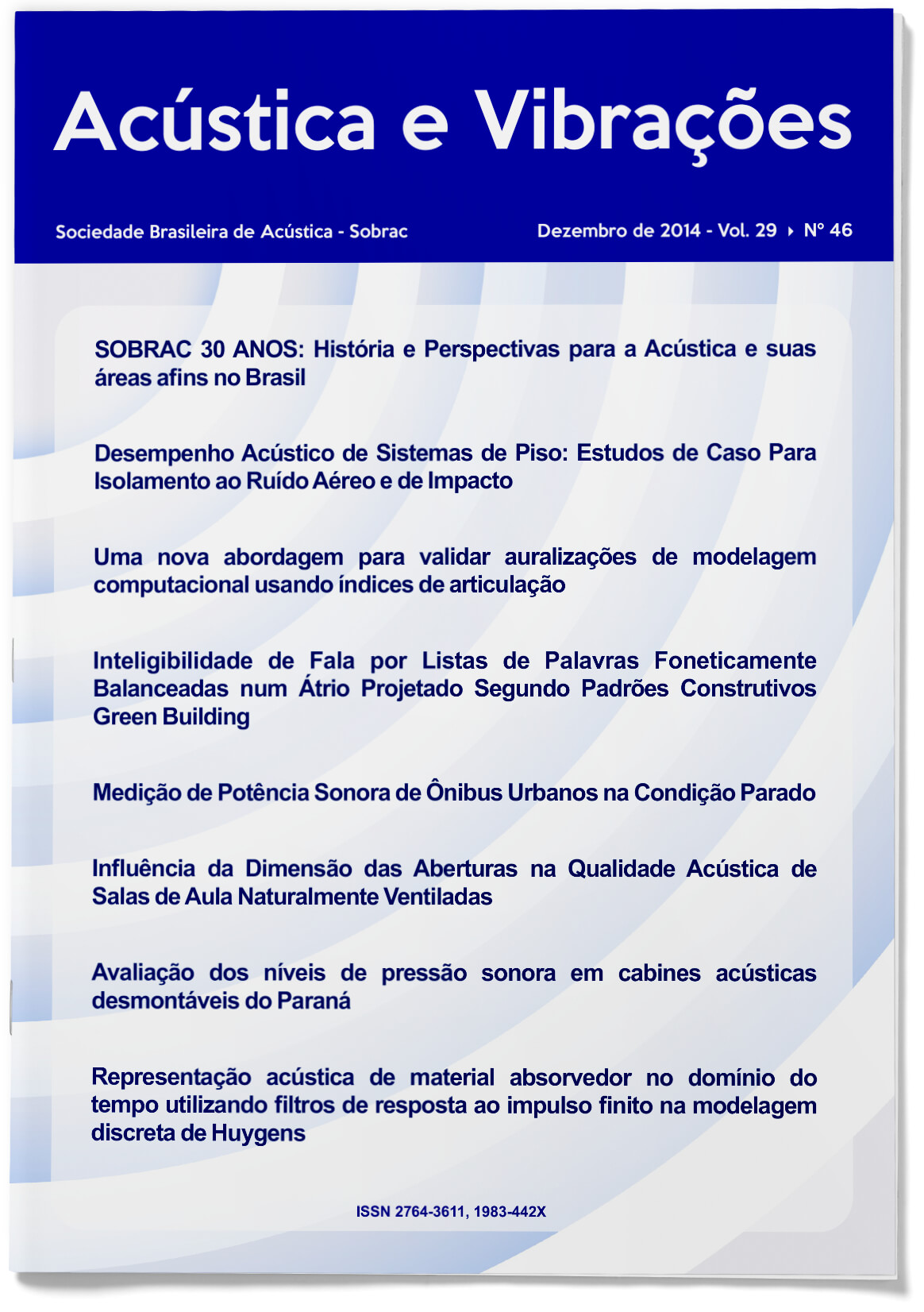
Acústica e Vibrações 46
Vol. 29 No. 46 (2014)Editorial
The Editorial Committee of Revista Acústica e Vibrações presents Edition n°46, consisting of articles selected at the XXV SOBRAC Meeting and others that had been submitted to the reviewers of this journal, through the entity's website, where this possibility is in continuous flow.
At the Closing Session of the XXV Meeting of SOBRAC, held from October 20 to 22, 2014, in the city of Campinas/SP, the works that obtained the best scores in the evaluation of the event's reviewers were published. The authors of such articles, after meeting the requests of the reviewers of Revista Acústica e Vibrações, are having their texts published.
For the composition of this issue, the articles were carefully analyzed and the themes selected.
Information about the new SOBRAC Board and other events complete this 46th Edition of the Revista da Sociedade Brasileira de Acústica.
The editors thank everyone who submitted their work and hope to receive new contributions for the next editions of Revista Acústica e Vibrações.
Newton Sure Soeiro
Ranny L.X. Nascimento Michalski
Elias Bitencourt Teodoro
Articles:
- SOBRAC - 30 YEARS: History and Perspectives for Acoustics and related areas in Brazil
- Acoustical Performance of Flooring Systems: Case Studies for Airborne and Impact Noise Insulation
- A New Approach to Validate Computationally Modeled Auralizations Using Articulation Indices
- Speech Intelligibility by Phonetically Balanced Word Lists in an Atrium Designed to Green Building Standards
- Sound Power Measurement of Urban Buses in the Stopped Condition
- Influence of the Dimension of Openings on the Acoustic Quality of Naturally Ventilated Classrooms
- Evaluation of sound pressure levels in demountable acoustic cabins in Paraná
- Acoustic representation of absorber material in the time domain using finite impulse response filters in discrete Huygens modeling
-

Acústica e Vibrações 45
Vol. 28 No. 45 (2013)Editorial
The Editorial Committee of Revista Acústica e Vibrações, issue n°45, presents to the Scientific Community a group of articles that are plural in their theme, but equitable in their quality and importance, which demonstrates the wide scope of the area of Acoustics and Vibrations.
For the composition of the magazine, articles were carefully analyzed and topics were selected that deal from aeronautical noise to urban noise, with emphasis on metropolitan transport and the impact resulting from pumping installations. There is also a concern with the inclusion of professionals in Acoustics and related areas in activities related to Sustainable Development and in the study of classrooms intended for the teaching of Music. The passive control of vibrations and the identification of sound sources by genetic algorithms complete the topics covered in the texts.
The details and deadlines for submitting papers for the XXV SOBRAC Meeting, which will be held from October 20 to 22, 2014, in Campinas/SP, as well as information about the Workshop supported by SOBRAC's North Region complete this 45th Edition from the Journal of the Brazilian Acoustic Society.
The editors thank everyone who submitted their work and hope to receive new contributions for the next editions of Revista Acústica e Vibrações.
Newton Sure Soeiro
Ranny L.X. Nascimento Michalski
Elias Bitencourt TeodoroContents in the magazine:
- Articles:
- The Role of Professionals in Acoustics and Related Areas in the Construction of Sustainable Development
- Noise Control in Metropolitan Transport
- Passive Control of Vibration in Electric Reactor Using Dynamic Viscoelastic Absorbers
- Study of the Acoustics of Rooms Focused on Music Teaching in Belém-PA
- Study of the Sound Impact Caused by Pumping Installations in an Urban Area
- Acoustic Quantities Related to Aeronautical Noise – Analysis and Works Performed in Brazil and Extended Classification Proposal.
- Identification of Sound Sources Via Genetic Algorithms
- Artificial Neural Networks Applied to the Simulation of Complex Aircraft Noise Scenarios
- Information:
- XXV Meeting of the Brazilian Acoustic Society
- I Workshop on Mechanical Engineering of the North Region
- Articles:
-

Acústica e Vibrações 44
Vol. 27 No. 44 (2012)Editorial
This special issue of Revista Acústica e Vibrações, again edited by the Board of SOBRAC – North Regional, is entirely composed of articles selected from the Annals of the XXIV Congress of the Brazilian Society of Acoustics (SOBRAC 2012), held by
first time in the North region, in Belém-PA, from May 29 to June 01, 2012.For the composition of the journal, articles from all sessions of the event were chosen, based on the evaluations of the reviewers of the Scientific Committee of SOBRAC 2012.
The participants of SOBRAC 2012 considered the event a real success, so this special issue of the Journal comes to crown all the effort undertaken, from the collection of some of the main articles that contributed most to raising the technical-scientific level of the Event.
The editors take advantage of this space to, once again, thank everyone who, in person or not, contributed to the success achieved in the realization of SOBRAC 2012 and hopes that the next event will be even bigger, in order to mark a continuous growth and solid foundation of our Brazilian Acoustic Society.
Newton Sure Soeiro
Gustavo da Silva Vieira de MeloSummary content:
- Technical norms and the responsibility of professionals working in acoustics;
- A methodology for virtual estimation of occupational noise exposure dose;
- Prediction of the loss factor of fuselage panels with viscoelastic materials using the theory of periodic structures and the finite element method;
- Vibroacoustic numerical analysis to predict sound pressure levels on the back of an electrical reactor;
- Evaluation of participation in a comparison of laboratories for sound absorption tests in tubes;
- Electroacoustic modeling of loudspeakers used as active sound absorbers;
- Characterization of sound absorption of corrugated acoustic barriers;
- Behavior of grooved and perforated panels incorporating synthetic foams;
- Analysis of urban acoustics in the neighborhood of Lagoa Nova, Natal/RN;
- Assessment of intelligibility in elementary school classrooms based on binaural impulsive responses obtained with an artificial infant head; and
- Evaluation of the acoustic performance of a traffic noise reduction device.
-
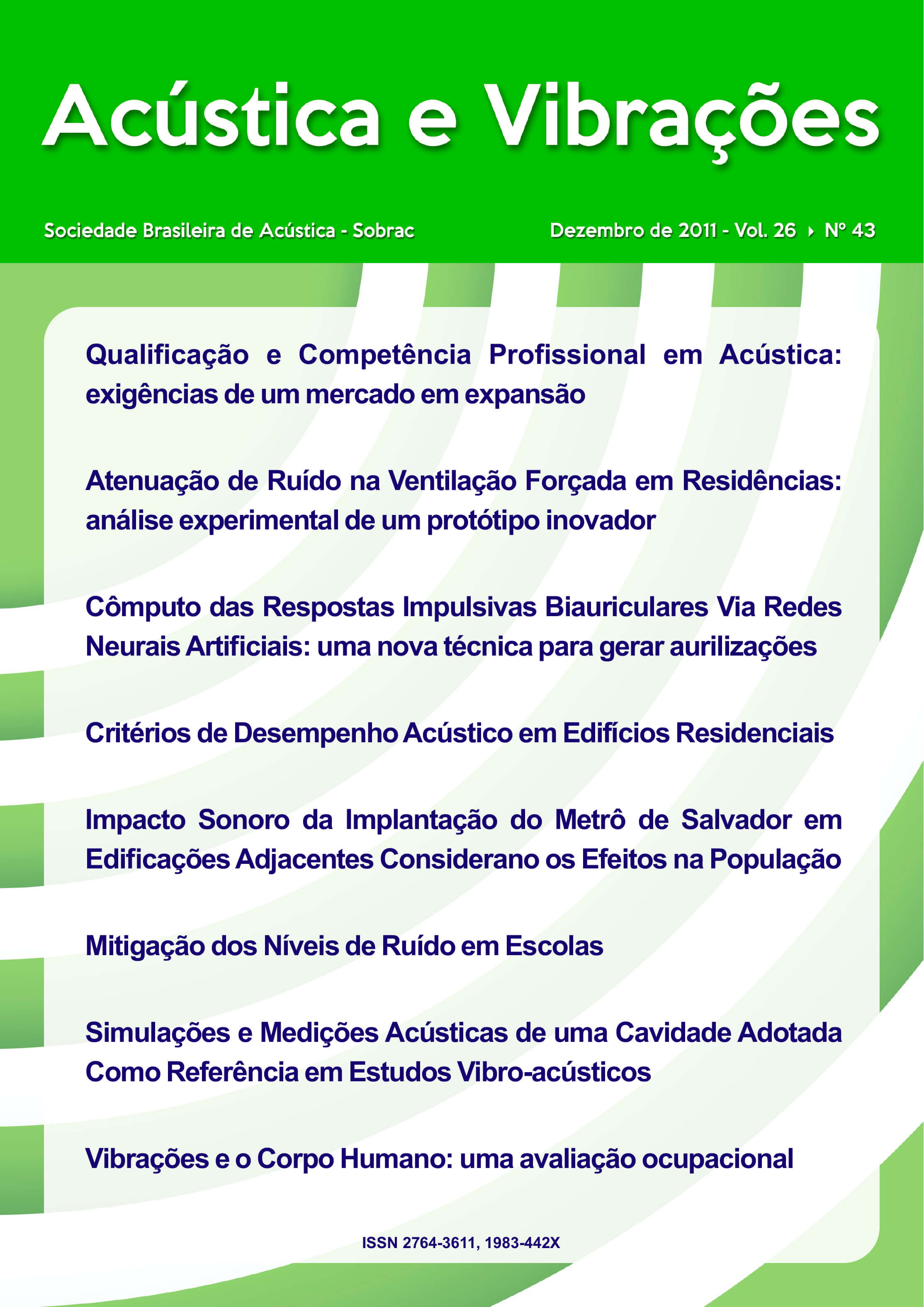
Acústica e Vibrações 43
Vol. 26 No. 43 (2011)Editorial
It was with great pleasure that the Board of SOBRAC – North Regional took on the task of editing this issue of Revista Acústica & Vibrações. This decision was based on the commitment previously made to preside over the XXIV Congress of the Brazilian Society of Acoustics (SOBRAC 2012), which will take place for the first time in the North region, and the construction of this issue of the Journal was seen as part of this Regional's contribution to the
members across the country.For the composition of the magazine, articles were requested from the entire Brazilian community of professionals who contribute to the areas of vibrations and acoustics. Thus, this issue of the Journal is significantly representative of the aforementioned areas of knowledge, as it contains articles from all regions of Brazil. During the process of reviewing the articles, there was an opportunity to alert the entire community about the need to deepen the discussion on the terminology used in vibrations and acoustics in Brazil. In this edition, fruitful and interesting debates emerged on terms such as “auralization” and “aurilization”, both accepted as valid with respect to the dimensions of each author, or even “diffusion”, “diffusivity” and “diffusibility”. We invite everyone to embrace the construction of appropriate terminology.
The editors sincerely thank the SOBRAC Presidency for the invitation to carry out this edition of the Journal and to all the people who sent articles, making this realization possible. Finally, they emphasize the immense expectation of being able to receive them in Belém-PA at SOBRAC 2012, an event that (literally) will mark the advance of the frontiers of Acústica & Vibrações of Brazil.
Newton Sure Soeiro
Gustavo da Silva Vieira de MeloSummary content:
- Qualification and Professional Competence in Acoustics: requirements of an expanding market;
- Noise Attenuation in Forced Ventilation in Residences: experimental analysis of an innovative prototype;
- Computation of Binaural Impulse Responses Via Artificial Neural Networks: a new technique to generate auralizations;
- Acoustic Performance Criteria in Residential Buildings;
- Noise Impact of the Implementation of the Salvador Metro on Adjacent Buildings Considering the Effects on the Population;
- Mitigation of Noise Levels in Schools;
- Simulations and Acoustic Measurements of a Cavity Adopted as a Reference in Vibro-acoustic Studies;
- Vibrations and the Human Body: an occupational assessment;
- International Noise Awareness Day – INAD – 2011 edition in Brazil;
- 1st Vibration and Acoustics Workshop in the North Region – Tucuruí-PA;
- Sobrac promotes historic meeting in São Paulo; and
- XXIV Meeting of the Brazilian Society of Acoustics –Belém – PA – 29/05 to 01/06/2012.
-
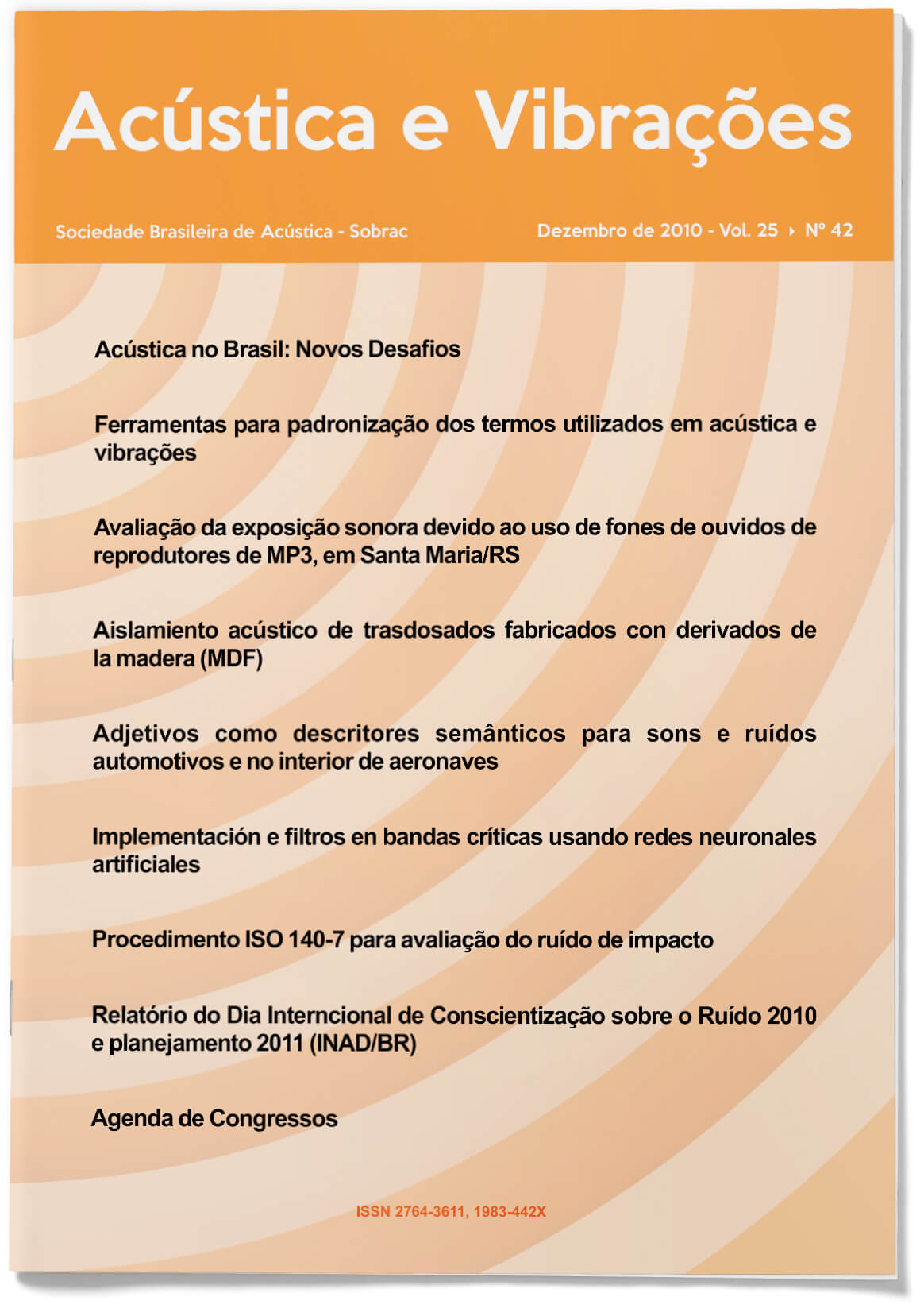
Acústica e Vibrações 42
Vol. 25 No. 42 (2010)Editorial
The number 42 of Acústica e Vibrações brings to the discussion topics relevant to Brazilian acoustics. The issue opens with a letter from the President of SOBRAC, Dinara X. da Paixão, who brings reflections on the current state of acoustics and SOBRAC.
The articles in issue 42, by authors from Brazil, Chile, and Spain, deal with issues such as terminology in acoustics, semantic descriptors, sound exposure through the use of headphones, the sound insulation of double walls with part of in MDF, the implementation of auditory filters from neural networks and impact noise assessment.
All these articles were reviewed by professors of acoustics from Brazilian universities. This procedure, adopted since issue 41, aims to improve the journal's Qualis grading, which is currently only B5.
In addition, given the layout problems that occurred in previous editions, which were fully or partially executed in MS Word, in this edition we chose to use the TEX-LATEX system for the entire journal.
Issue 42 also contains the report of activities carried out on the International Day of Awareness on the
Noise - INAD 2010. To differentiate the report from the technical-scientific articles, a different format was adopted for it. This procedure is also common in other journals that bring together informative material and technical articles in the same issue. The report shows that it is possible and necessary to share the issues of acoustics and noise pollution with society as a whole. The success of INAD 2010 actions is an invitation to engage new participants.All these actions are the result of efforts made towards the common goals of our community, which yearns for the rapid evolution of our professional sector.
We would like to thank all the researchers who contributed to the articles sent to the journal, especially those who understood the moment of change and transformation that began since the 41st journal. of the articles in this issue.
We all have the challenge of improving our Qualis classification at Capes. It is up to the board, the council, and perhaps the general meeting to decide the direction of the magazine, preferably defining the rules very clearly. We will only be able to expand the frequency of our journal, with the qualitative and quantitative increase in submissions.
We invite the entire community to send their criticisms, suggestions, and especially articles so that we can build the desired Acoustics and Vibrations that are recognized by all.
We invite Brazilian professors and researchers to join the discussion and formulation committee of the new editorial project of Acústica e Vibrações.
Krisdany Vinícius S.M. Cavalcante and Stephan Paul
Summary content:
- Acoustics in Brazil: New Challenges;
- Tools for standardization of terms used in acoustics and vibrations;
- Evaluation of sound exposure due to the use of mp3 player headphones, in Santa Maria/RS;
- Acoustic insulation of transdoses made with wood derivatives (MDF);
- Adjectives as semantic descriptors for automotive and aircraft interior sounds and noises;
- Implementation and filters in critical bands using artificial neural networks;
- ISO 140-7 procedure for assessing impact noise;
- Report on the 2010 International Noise Awareness Day and 2011 planning (INAD/BR); and
- Congress Agenda.
-

Acústica e Vibrações 41
Vol. 25 No. 41 (2010)Editorial
Acústica e Vibrações has undergone important changes in recent years under the current board of SOBRAC. The main driver behind these changes is the need felt by the acoustics and vibrations community for a quality, indexed local scientific journal. Currently, research works developed at the national level are, for the most part, restricted to presentation at national congresses and a small number of works are published in international scientific journals. This greatly restricts the dissemination of these works, such as master's and doctoral works, in addition to greatly limiting the exchange of information between members of the local community.
The initial idea was then to transform the journal Acústica e Vibrações into an indexed journal, and with this initial objective I accepted to assume the role of editor-in-chief of the journal. The first step was a survey of information regarding the indexing process of a scientific journal. For this purpose, different sources were consulted, including the Scielo database (one of the main databases in the country), people linked to the journal incubator at the Federal University of Santa Catarina, personnel linked to CAPES, in addition to participation in a seminar on the editorial process of scientific journals. In general, the rules for indexing a scientific journal depend on the database chosen, but what can be seen is that many of the indexing criteria of most databases would be difficult to implement in the journal Acústica and Vibrations. Take, for example, the requirements of the Scielo database to provide online content, currently exclusive to SOBRAC members, and purely scientific content, excluding articles of a technological nature that are of interest to many members. In addition, with the transformation into a scientific journal, the journal Acústica e Vibrações could no longer perform its functions as a communication and dissemination tool between the board and associates.
Due to these difficulties and limitations, a new proposal was evaluated: a new journal would be created in the area of acoustics and vibrations, with a scientific character and meeting the indexing criteria of the main databases. In this way, many of the problems associated with the transformation of the journal Acústica e Vibrações into a scientific journal were avoided, in addition to maintaining the latter's functions as a means of communication for the board and its technological character. The solution involving two journals in the area of acoustics and vibrations, one scientific and the other of a more technological nature, follows the examples of other international societies in the area of acoustics and vibrations, such as the American Society of Acoustics (ASA), which publishes the journal “Acoustics Today”, with an informative and technological profile, and the “Journal of the Acoustical Society of America” (JASA), of a scientific nature, and the European acoustic societies, which publish the “Acta Acústica United with Acustica” and which, in their Most also have a technological and informative magazine. Another important change in relation to the initial idea concerns the editorial board, which should not be directly linked to SOBRAC (whose board changes every 4 years), thus seeking to ensure continuity in the editorial line of the new journal.
The fact that the new journal is not directly linked to SOBRAC also opens up space for seeking to include the acoustics and vibrations community in other Latin American countries, which also lack a local scientific journal, which leads to suggestion of the name “Jornal Latino-Americano de Acústica” for the new magazine. In any case, the support of SOBRAC and other Latin American acoustic societies will be fundamental to the success of this undertaking. The project of the new magazine is in an advanced state and more information should be made available on the SOBRAC website soon.
In view of the option to create a new scientific journal, number 41 of the Acústica e Vibrações journal maintains the format of the previous numbers. However, an effort was made to have the submitted articles reviewed. A total of 14 articles were submitted to the journal through the SOBRAC website, and 6 articles were accepted with modifications suggested to the authors, thus guaranteeing the quality of the articles published.
Issue 41 of the journal is the latest issue under the current board. With the change of board, I also leave the position of editor, which will have to be appointed by the new board, and I will dedicate myself to the work of organizing the Jornal Latino-Americano de Acústica. Finally, I would like to thank the support received during my time as editor, especially from Prof. Stephan Paul, from the Federal University of Santa Maria, and the current board of SOBRAC.
Julio A. Cordioli
Summary content:
- A review of methods for in situ measurement of surface acoustic impedance;
- A summary of acoustic performance in residential buildings according to the Brazilian standard ABNT NBR 15575;
- Analysis of mapping studies of sound pressure levels and assessment of noise nuisance in the cities of Maringá and Curitiba in the state of Paraná;
- Thermoacoustic control of a thermogenerator unit: a case study;
- The assessment of environmental noise in industries in the city of Curitiba for social security purposes;
- Assessment of environmental noise pollution – standards and laws used in Brazil; and
- Railway noise.
-

Acústica e Vibrações 40
Vol. 24 No. 40 (2009)Editorial
The General Assembly of Sobrac, held in Belo Horizonte on November 26 and 27, 2008, established that the editorial reformulation of the Acústica e Vibrações magazine, which began with issue number 38, should be continued.
To this end, it was decided that Sobrac's Board of Directors would appoint an editor-in-chief, whose main task would be to convene the editorial board appointed in 2006 so that it effectively and immediately begins its activities.
Another important decision of the assembly was to seek the indexation of the journal from the research funding agencies (Capes and CNPq).
Doctor Engineer Júlio Cordioli, who currently holds the position of Visiting Professor at the Federal University of Santa Catarina, accepted our invitation and will be the first effective Editor-in-Chief of Revista Acústica e Vibrações.
The appointment of Júlio brings, in the last year of this administration, a new perspective for our Journal, which after winning the ISSN, will have a body of reviewers, in the search for a scientific qualification.
Number 40 of Revista Acústica e Vibrações maintains the same line as the last three editions, with eight technical articles and information regarding the congresses to be held in 2009. All articles were sent through the Sobrac website, an expedient that has proved to be very practical. and efficient.
The commercial advertisements on the back covers of 40 magazine were replaced by publicity pieces for technical events. The yellow pages booklet with the announcements of our institutional associates will be edited separately and distributed as of May 2009.
We hope that this issue pleases members and encourages colleagues to submit articles for publication in the next issue, which will be reviewed by the new editorial board to be formed soon.
Marco Antonio Nabuco de Araujo
Summary content:
- Measurement of absorption coefficient of impedance tube membrane absorbers using a pu probe;
- The environmental acoustic quality in public school classrooms, its influence on the teaching-learning process and on the teacher's quality of life;
- ISO 140-4 and ISO 140-5 Procedure for Sound Insulation Measurement;
- Binaural signal acquisition technology – a history to current projects;
- International Noise Awareness Day – Campaign in three cities in southern Brazil;
- Evaluation of traffic noise as an index of noise pollution;
- Acoustics and Recycling of Buildings: Study of Capela Santa Maria in Curitiba; and
- Sound Perception in Two Green Areas in Curitiba: Noise Tolerance Indicators in Public Spaces.
-

Acústica e Vibrações 39
Vol. 23 No. 39 (2008)Editorial
Eight technical articles were submitted for issue 39 of the Acústica e Vibrações, all of them through the Sobrac website, which made the assembly of the magazine less laborious. It is quite true that not all articles were entirely in the format. Some present color figures where the color clearly lends quality to the information in the article, but unfortunately the cost of color prints is known to be high, and they were printed in black and grayscale.
The journal still does not have an editorial committee that reviews the submitted articles, and thus all were accepted. In issue 38 of Acústica e Vibrações, an interview was published with two personalities of the Society about the magazine. We hope that in 2009 we will be able to start the Forum on the Acústica e Vibrações magazine.
The interview in this issue is with Professor Ieda Russo and deals with various issues related to the area of acoustics and speech therapy.
The number 39 of Acústica e Vibrações is also available on the Sobrac website, with the figures in color. We hope you like it and as soon as the Forum goes live, participate and send suggestions about the desired profile for our magazine.
Marco Antonio Nabuco de Araujo
Summary content:
- Comparison between the Traditional Method and the Sound Intensity Method in the Determination of Acoustic Insulation Indexes;
- The sounds emitted by religious temples, in the view of neighbors and regulars;
- Acoustic evaluation of the recording room of the audio studio of the Department of Arts at the Federal University of Paraná;
- Building acoustics: indices of insulation to percussion sounds used in Europe;
- Environmental acoustic impact in Santa Maria-RS;
- Acoustics of buildings: indices of insulation to airborne sounds used in the European space;
- Evaluation of Community Noise in the Central Region of the City of Maringá-PR; and
- Voice and guitar auralization – A comparative approach of different simulation methods.
-

Acústica e Vibrações 38
Vol. 22 No. 38 (2007)Editorial
One of the goals of SOBRAC's current management is the reformulation of the "ACÚSTICA E VIBRAÇÕES" magazine. Initially, a Provisional Editorial Board was set up, seeking to bring together representatives of educational institutions, consultants, and professionals linked to companies operating in the area. The functioning of the council ran into some practical and conceptual issues of functioning. In the last Ordinary General Assembly of SOBRAC, whose Minutes are transcribed in this edition, the creation of a forum on the new SOBRAC website (www.acustica.org.br) for the reformulation of the magazine was approved. To open the discussion of the new magazine, we included in this number 38 an interview with two of the best-known members of the Society, Fernando Aidar and Moysés Zindeluk, in which part of their opinions can be known. Also thinking about the reformulation of SOBRAC, we published the rules of a contest open to associates to create a new logo for the Society.
While the reformulations are discussed by SOBRAC members, as long as necessary, this issue presents some technical articles. The first idea was to publish the articles from the conferences and workshops presented at the XXI SOBRAC Meeting, São Paulo (November 2006). However, due to the tight deadline, we were able to gather only two of these works for issue number 38. In early January 2007, the current administration invited members to send original articles for the composition of the current issue. We received and published the very valuable contributions of names such as João Baring, Débora Barreto, Márcio Avelar Gomes and Swen Müller.
In this issue, it was decided to publish in a separate insert the pages with the announcements of institutional members who were interested in publishing their companies in the ACÚSTICA E VIBRAÇÕES. We hope that the content of the issue fulfills its informative purpose and that the next editions will already contain the reformulations prepared with the participation of the associates.
Paulo Medeiros Massarani
Summary content:
- Sustainability and acoustic control of the environment;
- Sound impact of the implementation of the Salvador subway in adjacent buildings, considering the impact on the health of the population;
- Implementation of Methods for Acoustic Simulation and Auralization of Rooms;
- Readability evaluation using the STI;
- Acoustic Evaluation of Theaters; and
- Evaluation of the acoustic performance of in situ audiometric booths.
-
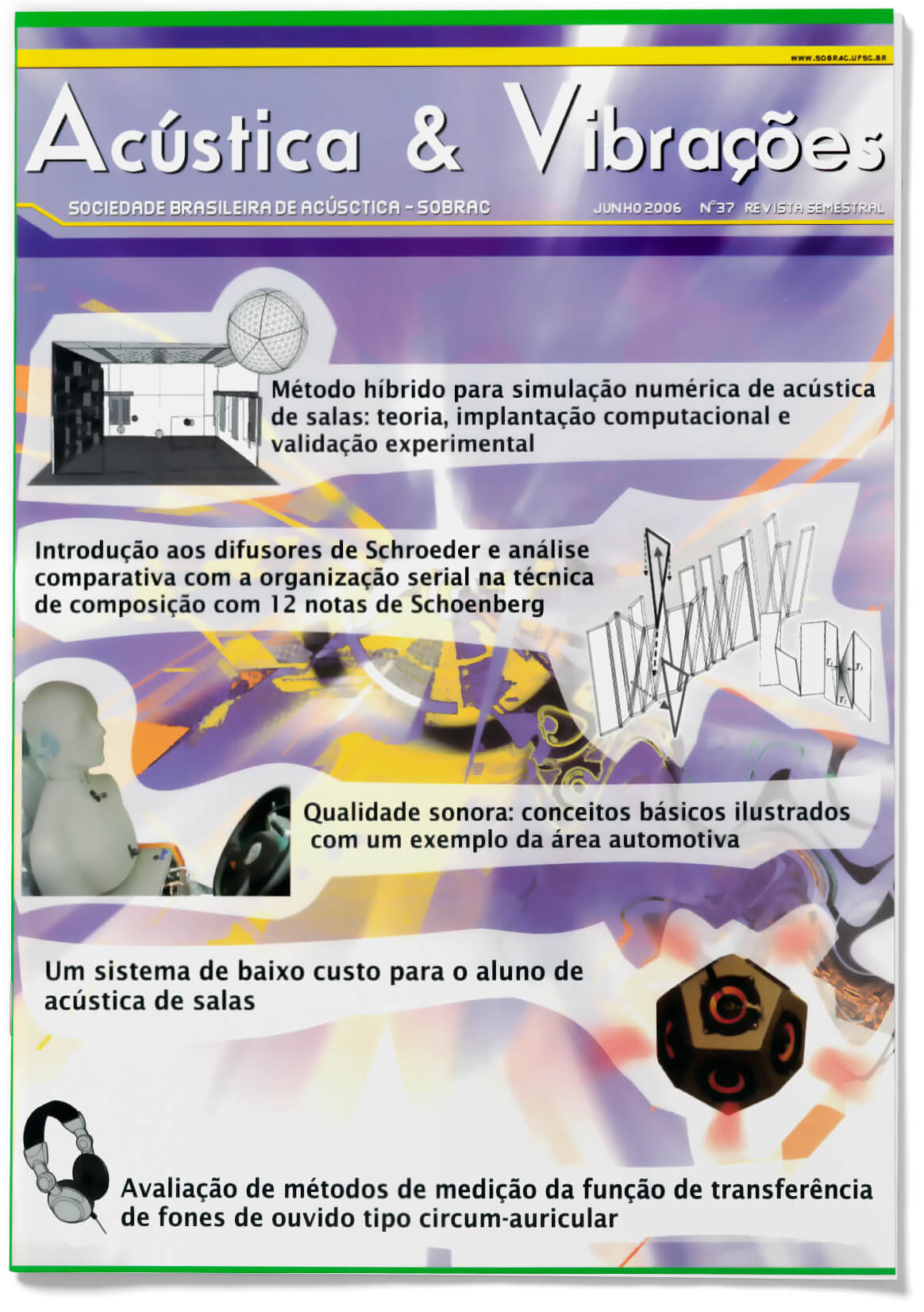
Acústica e Vibrações 37
Vol. 21 No. 37 (2006)Editorial
On February 16, 2006, the Board of Directors elected for the 2006-2010 quadrennium took office in São Paulo at the Headquarters of the Institute of Weights and Measures. On that occasion, when more than 40 associates attended the Inaugural General Assembly, former president Samir N. Y. Gerges presented a summary of the activities developed by Sobrac in the period 2002-2006, which includes the realization of Internoise 2005, the largest event organized by our Society since its creation in 1994, and which has definitely projected it on the international scene.
Subsequently, the new Board of Directors resubmitted the proposals with which we applied for the next quadrennium, proposals that include the presentation of a certification program for professionals to measure noise, the transparency of Sobrac's accounts, the holding of traditional events society and also the revitalization of the Acústica & Vibrações magazine.
Colleague Paulo Massarani will coordinate the work of a Temporary Editorial Board-CET, whose activities will focus mainly on defining a set of criteria for the formation and functioning of the Editorial Board of the Brazilian Society of Acoustics, a fundamental requirement for the request for indexing of the Sobrac magazine with the relevant organizations. Despite CET's well-defined mission, the December issue of Revista Acústica & Vibrações should already have articles that have been minimally evaluated according to the criteria that will be presented for approval at the General Assembly of Sobrac to be held next November in São Paulo. The July 2006 issue was edited without these changes or editorial review by the CET.
More than 40 experts from universities, research institutes, private companies and consultants were invited to form the Temporary Editorial Board. The names of the 16 who agreed to collaborate are listed below:
Professor Doris Ruth Lewis, PUC-SP; Prof. Fernando Pinto, COPPE/UFRJ; Professor Beatriz Mendes, PUC-SP; Prof. Paulo Zannin, UFPR; Prof. Sylvio Bistafa, USP; Prof. Samir Gerges, UFSC; Professor Stelamaris Rolla, Unicamp; Professor Elvira Viveiros, UFSC; Marcio Avelar, Unicamp; Professor Dinara Paixão, UFSM; Prof. Marco Vecci, UFMG; Prof. Roberto Tenenbaum, IPRJ/UERJ; Prof. Eduardo Buazer, UFMG; Marcelo Magalhães, FORD Brazil; Prof. Ricardo Musafir, COPPE/UFRJ; and Sílvio Pinheiro da Silva Jr., GROM.A new website for Sobrac should be up and running by mid-July. This work is being organized by the 1st Secretary of Sobrac Gilberto Fuchs. Until the closing date of this editorial, Sobrac had a staff of 60 effective members, 25 institutional members and 11 students up to date. Our goal is to double the number of effective members in 2006 and increase the number of students significantly, seeking the adhesion of students from courses such as speech therapy, medicine and architecture.
With these measures, and others related to the organization and promotion of technical/scientific events, such as Sobrac meetings and even international congresses of the magnitude of Internoise or ICSV, we hope to consolidate the Sociedade Brasileira de Acústica as an organization that brings together in a very representative way professionals and future professionals in the fields of acoustics and vibration sciences.
Marco Antonio Nabuco de Araujo, President of Sobrac
Summary content:
- Hybrid Method for Numerical Simulation of Room Acoustics: Theory, Computational Implementation and Experimental Validation;
- Introduction to Schroeder's diffusers and comparative analysis with serial organization in Schoenberg's 12-note composition technique;
- Sound quality: basic concepts illustrated with an example from the automotive area;
- A low cost system for the room acoustics student; and
- Evaluation of methods for measuring the transfer function of over-the-ear headphones.
-
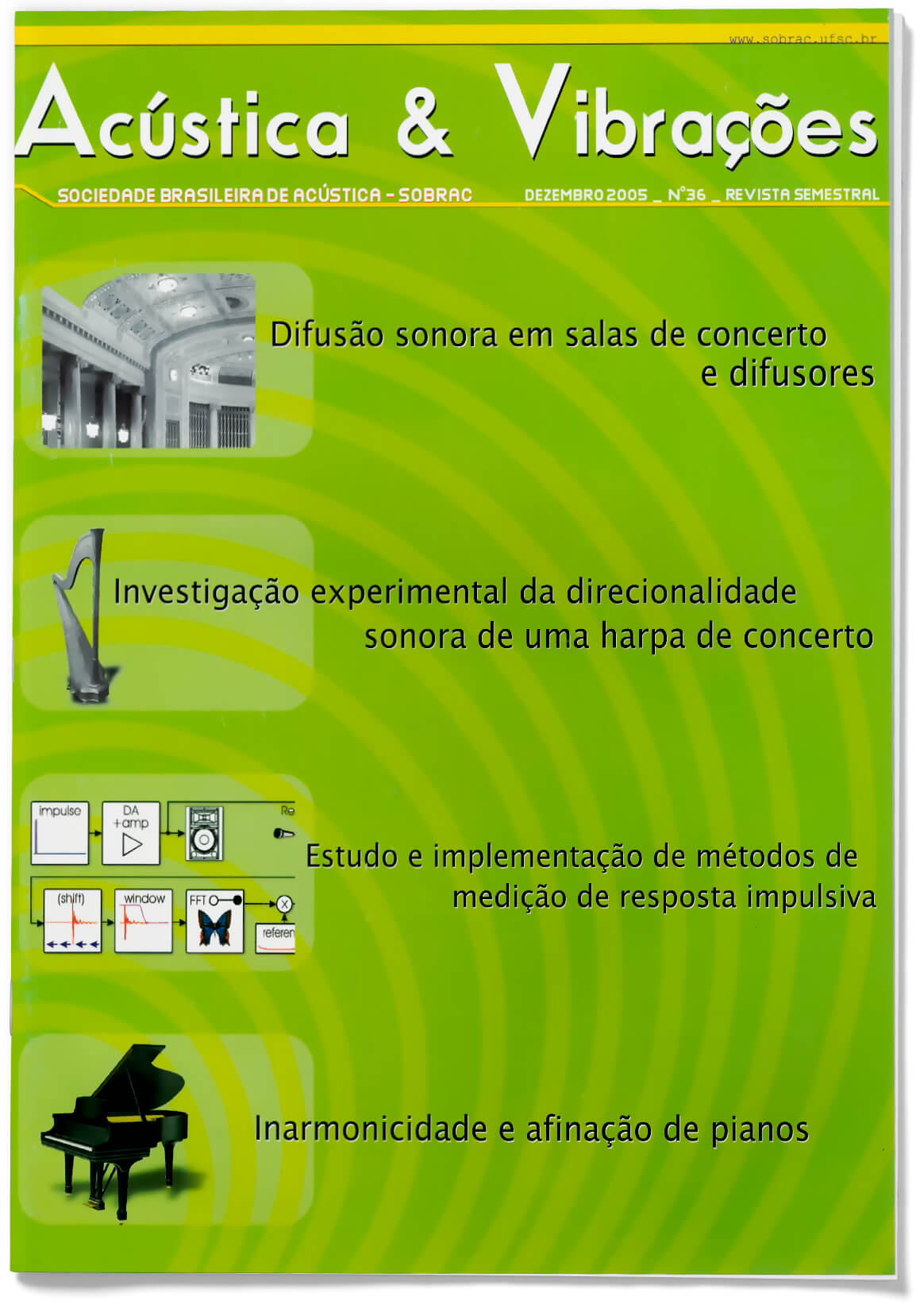
Acústica e Vibrações 36
Vol. 20 No. 36 (2005)Editorial
It is always healthy for an organization to assess its mission and objectives and propose changes to guarantee its contribution and continue its existence. This has always been SOBRAC's vision.
Founded on November 21, 1984, the Sociedade Brasileira de Acústica aims to disseminate information among researchers, manufacturers, consultants and users. The magazine “Acústica e Vibrações” is published every six months and covers activities, events and research in the area of vibrations and noise. It is distributed to Brazilian partners and other international acoustic societies.Since 1985, SOBRAC has been a member of the I-INCE (International Institute of Noise Control Engineering), the IIAV (International Institute of Acoustics and Vibration), the ICA (International Commission of Acoustics) and the FIA (Federação Iberoamericana de Acústica), participating in the discussions for the elaboration of the Silence Law, in 1990, and the Vehicular Noise Law, in 1993. They also have representatives in ABNT (Brazilian Association of Technical Norms) and in other institutions related to safety at work and acoustic comfort.
The society is made up of several working groups: the Ruído Veicular group, responsible for organizing symposia in São Paulo; Building Acoustics, which promotes joint meetings with Ergonomics and Thermal Comfort groups; and the Hearing Conservation and Hearing Protectors group, which works with other occupational safety and medicine entities.
During my term as president, we managed to consolidate SOBRAC at a national and international level. We effectively participate in international congresses representing Brazil, such as in the Congress Selection Committee of I-INCE, the entity that decides on I-INCE congresses, and in the Board of Directors of ICA and IIAV. We managed to bring the biggest congress, International Congress of Noise Control Engineering – Internoise 2005 to Brazil, after 20 years of struggle, which was held from August 7th to 10th, 2005, at SOFITEL, Rio de Janeiro, with the presence of a thousand participants from 43 countries, three courses, six invited lectures, 36 parallel technical sessions, 529 technical papers presented, which shows the great success of this event in Brazil (visit the website http://www.internoise2005.org.br for see the program executed and photos of the event).
The SOBRAC magazine “Revista de Acústica e Vibrações” is published in July and December, and its special edition of
July 2005 was the book of abstracts for Internoise 2005. As of the December 2005 edition, the magazine acquires a new format following the international standard. As of 2006, a new board will take over the direction of SOBRAC with a new editorial board for the magazine.Finally, I would like to thank everyone for the support given during my term and I wish the next president and board of directors for 2006-2008 a job full of accomplishments.
Samir N.Y. Gerges, President of SOBRAC 2002–2005
Summary content:
- Sound diffusion in concert halls and diffusers;
- Experimental investigation of the sound directionality of a concert harp;
- Study and implementation of impulsive measurement methods; and
- Inharmorability and tuning of pianos.
-
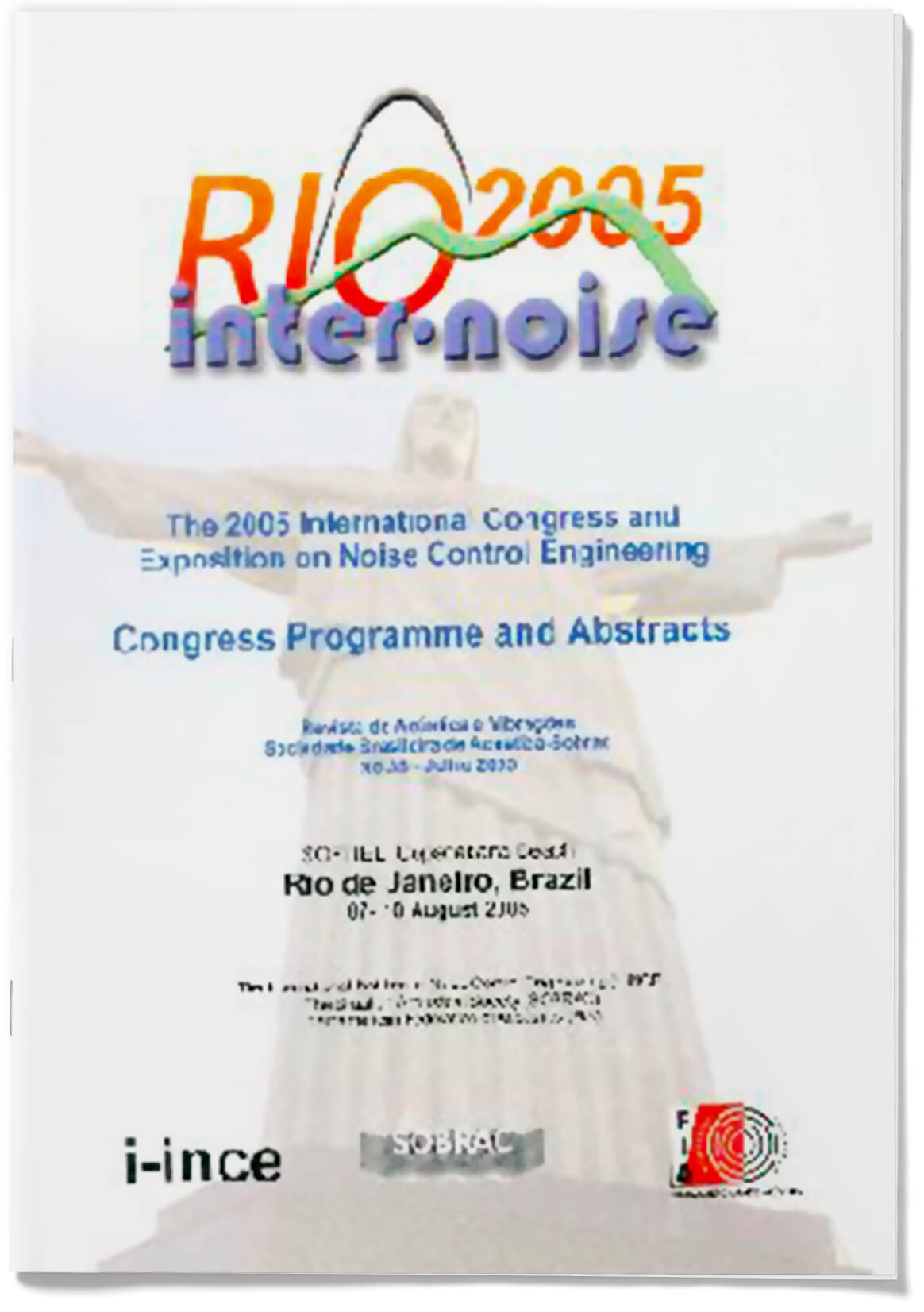
Acústica e Vibrações 35
Vol. 20 No. 35 (2005)Welcome Message
Dear Colleagues,
It is with great pleasure that we host the Internoise 2005 Congress being held from 7 to 10 August 2005 which is sponsored by I-INCE and organized by the Brazilian Acoustical Society (SOBRAC) together with the Ibero-American Federation of Acoustics (FIA). The Congress venue will be the SOFITEL Hotel on the beautiful Copacabana beach in Rio de Janeiro, Brazil. The main theme of the Congress is ENVIRONMENTAL NOISE CONTROL, but technical papers in all areas of noise and vibration control are very welcome. This may be your first visit to South America but we doubt it will be your last. At this Internoise 2005 Congress, you will not only exchange information with your international colleagues but will also be able to discover the high potential for noise and vibration control engineering in South America. Brazilian industry is ever-increasing, with products such as passenger jet airplanes, and some of the largest automotive assembly plants in the world, representing major brands. And these are but two of the many categories of South American products for which noise and vibration technology plays a very important role regarding reliability, comfort, and quality. Other categories include hydroelectric and thermal power plants, food industries, domestic appliance manufacturers, construction companies, and many others.
Recently, as a consequence of the worker’s union activities and political changes, a team of government health and safety officers has been created and now enforces noise and vibration limits in the industry. In addition to noise and vibration limits in the workplace, the federal and local governments have specified new environmental limits for noise in residential and other noise-sensitive areas. The effort is been focused on product sound quality improvement in many of the industries.
The birth and growth of SOBRAC in the last 21 years have occurred in parallel to the increasing level and size of the academic and technical community, dealing with acoustics and vibration in Brazil. A significant number of universities and research centers, both governmental and private, have created divisions and labs to address our area, noise and vibration control being the main field of application.
All of these activities require training and consulting, measurement and analysis equipment, noise and vibration prediction tools, control materials, and manufacturing technologies for noise and vibration solutions. Internoise 2005 will provide the opportunity to exchange ideas and make contact with emerging activities on this large continent. We expect a very rich exhibition of worldwide noise and vibration equipment, software, and materials for noise and vibration control. Pre-congress courses and distinguished speakers will provide information on up-to-date technologies in the field. We thus welcome you to Internoise 2005, where you will have a fruitful and enjoyable time in beautiful, tropical Brazil.
Samir N. Y. Gerges, President Internoise 2005
Summary content:
- The 2005 International Congress and Exposition on Noise Control Engineering Congress Programme and Abstracts.
-
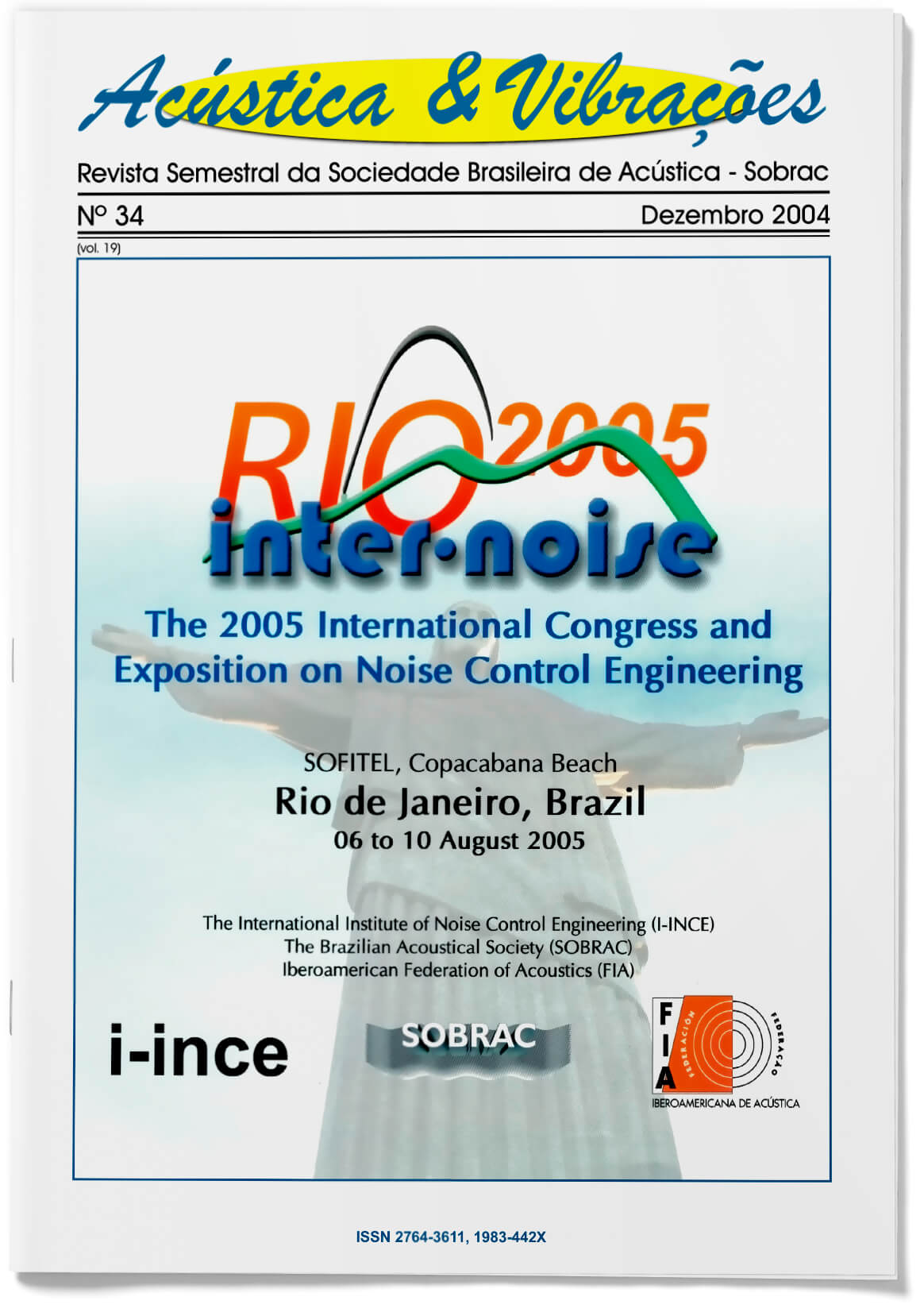
Acústica e Vibrações 34
Vol. 19 No. 34 (2004)Summary content:
- Comparative statistical analysis of urban noise in the city of Curitiba;
- Reliability of classical methods for analyzing failures in bearings in the paper industry;
- Noise in the territorial order of the municipality of Providencia, Chile; and
- Analysis of the annoyance caused by urban noise in public places in the city of Feira de Santana, Bahia, Brazil.
-
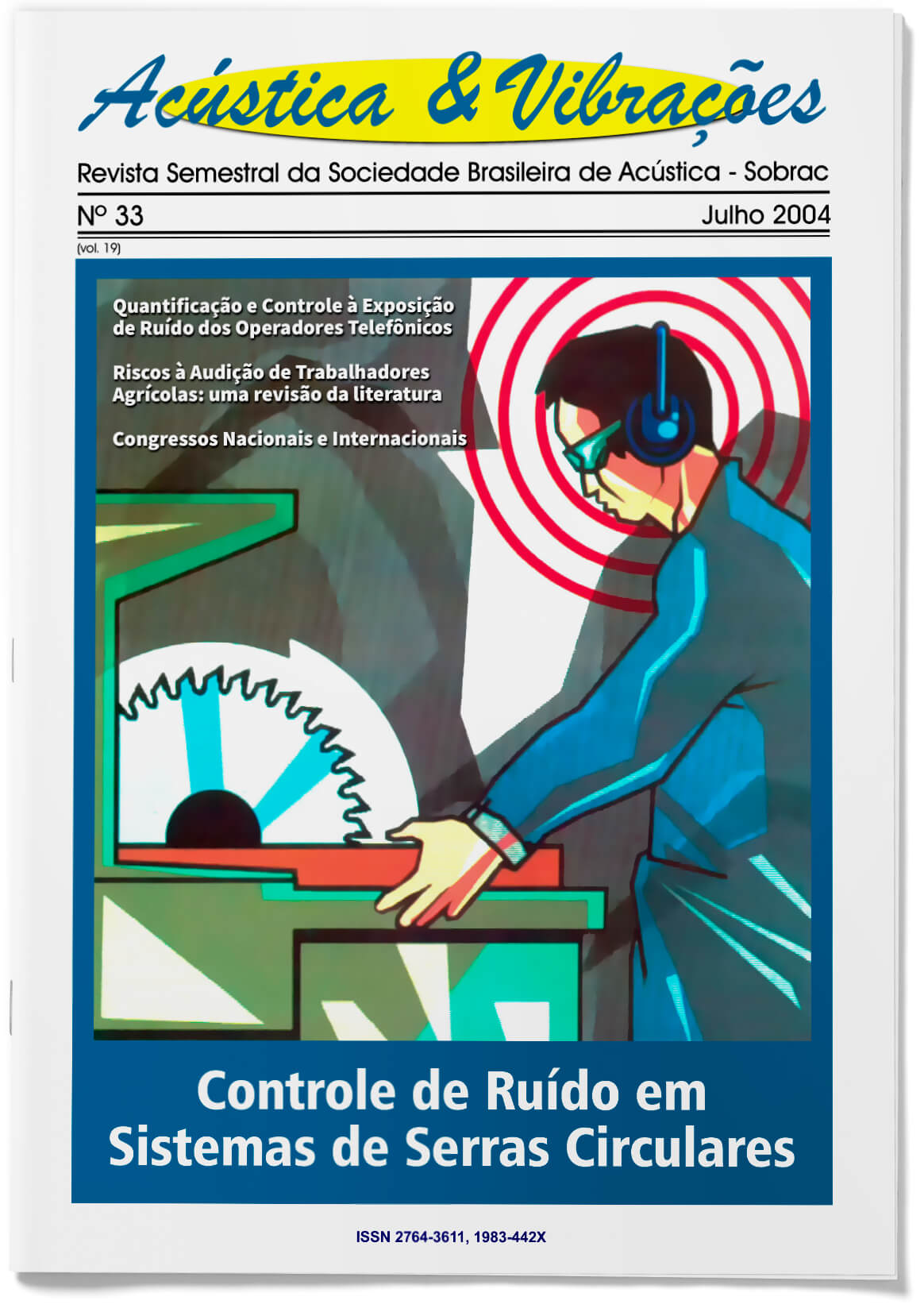
Acústica e Vibrações 33
Vol. 19 No. 33 (2004)Summary content:
- Noise control in circular saw systems;
- Quantification and control of noise exposure of telephone operators; and
- Hearing risks for agricultural workers: a literature review.
-
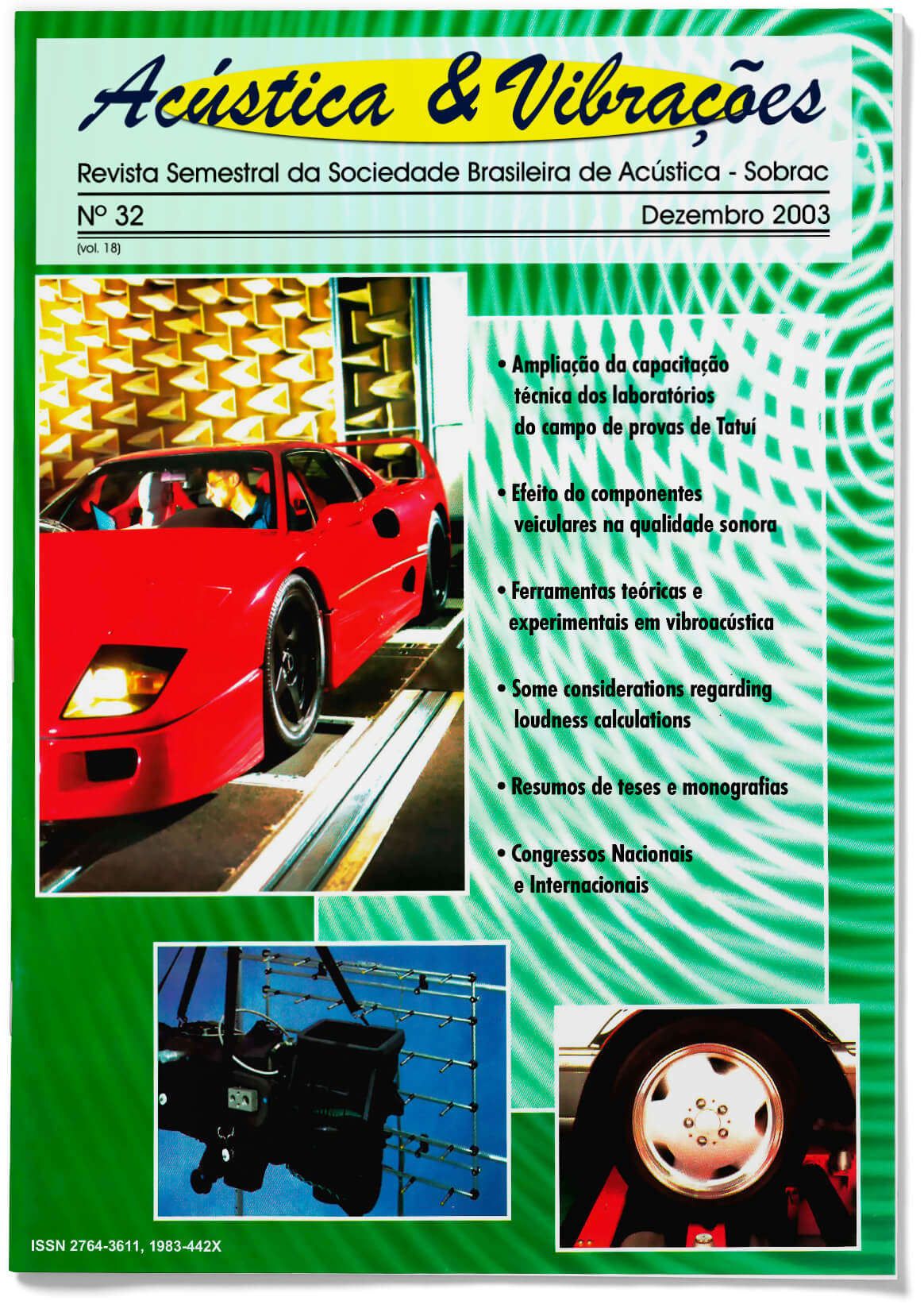
Acústica e Vibrações 32
Vol. 18 No. 32 (2003)Summary content:
- Expansion of the technical qualification of the laboratories of the test field of Tatuí;
- Effect of vehicle components on sound quality;
- Theoretical and experimental tools in vibroacoustics;
- Some considerations regarding loudness calculations; and
- Abstracts of theses and monographs.
-

Acústica e Vibrações 31
Vol. 18 No. 31 (2003)Summary content:
- Classroom acoustics: case study in two private schools in the Federal District;
- Solutions for reducing the occupational exposure of workers in the automotive area; and
- Abstracts of theses and monographs.
-
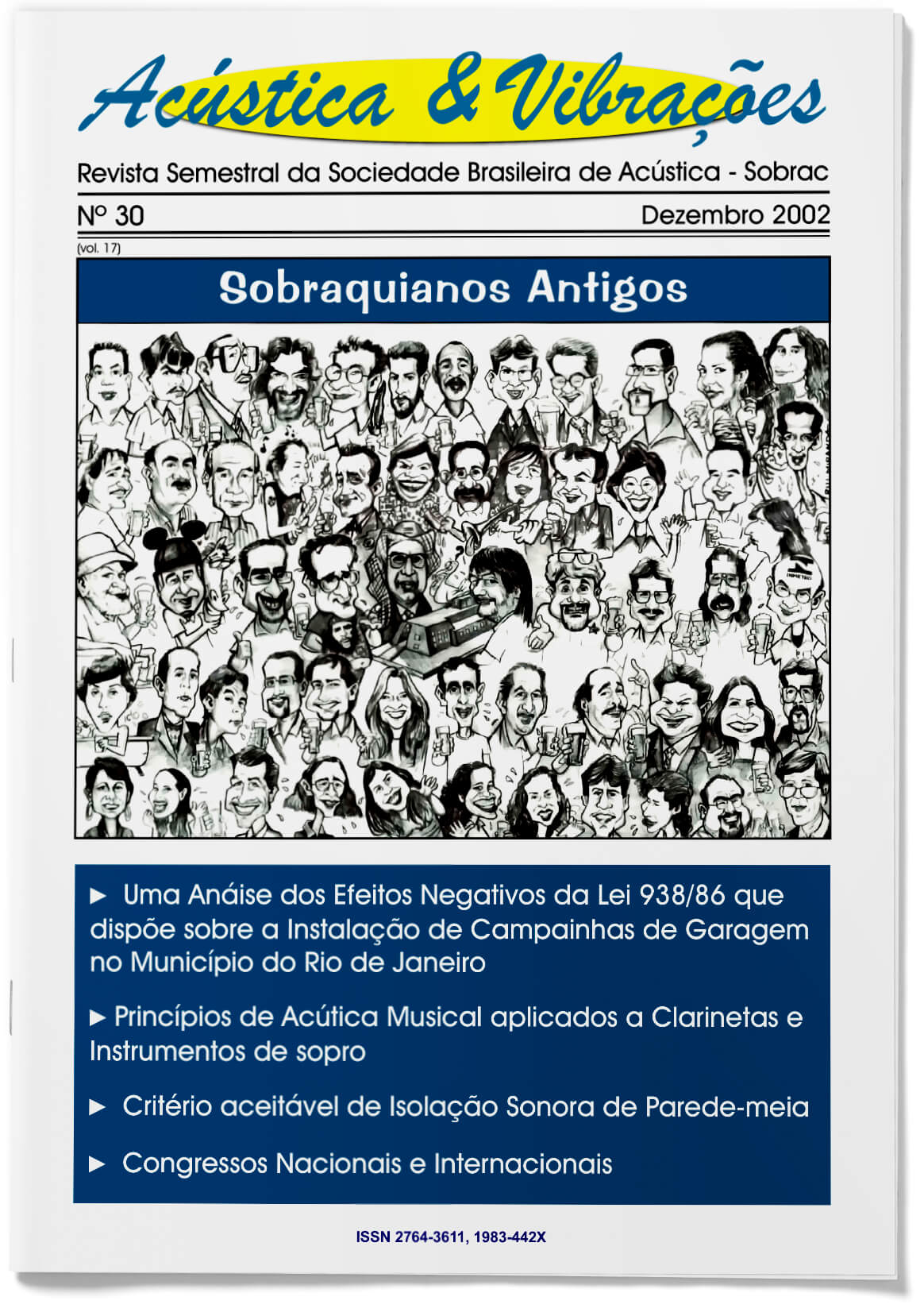
Acústica e Vibrações 30
Vol. 17 No. 30 (2002)Summary content:
- An analysis of the negative effects of Law 938/86 which provides for the installation of garage bells in the Municipality of Rio de Janeiro;
- Principles of musical acoustics applied to clarinets and wind instruments; and
- Acceptable middle-wall sound insulation criteria.


